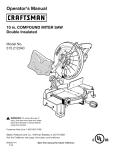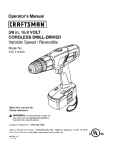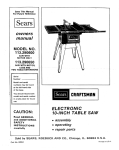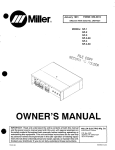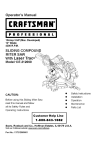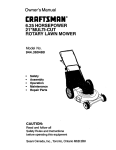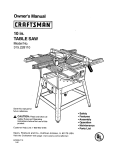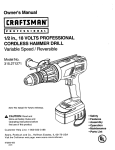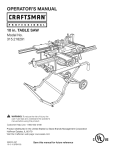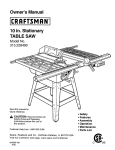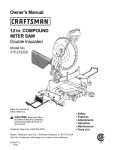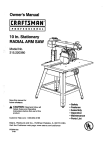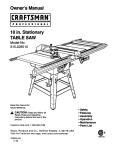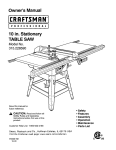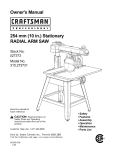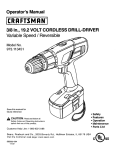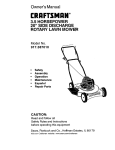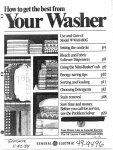Download Craftsman 315.22839 Saw User Manual
Transcript
Owner's Manual
II:RRFrSMRN I
10 in. Stationary
TABLE SAW
Model No.
315.228390
Save this manual for
future reference
• Safety
• Features
• Assembly
• Operation
• Maintenance
• Parts List
_, CAUTION:
Read and follow all Safety
Rules and Operating Instructions before first
use of this product.
Customer
Help Line: 1-800-932-3188
Sears, Roebuck and Co., Hoffman
Estates, IL 60179
Visit the Craftsman web page: www.sears.com/craftsman
972000-780
10-02
USA
FULL ONE YEAR WARRANTY
ON CRAFTSMAN
TABLE SAW
If this rRRFTSMRN Table Saw fails due to a defeat in material or workmanship
of purchase, Sears will repair it, free of charge.
within one year from the date
Contact a Sears Service Center for repair.
If this product is used for commercial
of purchase.
or rental purposes, this warranty applies only for 90 days from the date
This warranty gives you specific legal rights, and you may also have other rights which vary from state to
state.
Sears, Roebuck
and Co., Dept. 817WA, Hoffman
Estates, IL 60179
Your saw has many features for making cutting operations more pleasant and enjoyable. Safety, performance
and dependability have been given top priority in the design of this saw making it easy to maintain and operate.
,_
CAUTION:
Carefully read through this entire owner's manual before using your new saw. Pay close
attention to the Rules For Safe Operation, and all Safety Alert Symbols, including Danger, Warning and
Caution. If you use your saw properly and only for what it is intended, you will enjoy years of safe, reliable
service.
,_
Look for this symbol to point out important safety precautions.
_,
WARNING:
It means attention!!! Your safety is involved.
The operation of any power tool can result in foreign objects being thrown into your eyes,
which can result in severe eye damage. Before beginning power tool operation, always
wear safety goggles or safety glasses with side shields and a full face shield when needed.
We recommend a Wide Vision Safety Mask for use over eyeglasses or standard safety
glasses with side shields, available at Sears Retail Stores.
•
Warranty and Introduction .............................................................................................................................
•
Table Of Contents ......................................................................................................................................
2-3
•
Rules For Safe Operation ...........................................................................................................................
4-6
•
Electrical
•
Glossary and Product Specifications ............................................................................................................
8
•
Unpacking and Accessories
9
•
Loose Parts List ..........................................................................................................................................
•
Small Parts List ......................................................................................................................................
•
Tools Needed ..............................................................................................................................................
•
Labels .....................................................................................................................................................
14-15
•
Features .................................................................................................................................................
16-17
•
Assembly ................................................................................................................................................
18-29
.......................................................................................................................................................
.........................................................................................................................
Installing Handwheels on Table Saw Base .................................................................................................
Assembling Leg Stand ...........................................................................................................................
CRRFTSMRN_TABLESAW315.228390
2
2
7
10
11-12
13
18
18-19
•
•
Mounting
the LegStandontheTableSawBase........................................................................................
19
Assembling
TableExtensions
.....................................................................................................................
20
AligningTableExtensions
...........................................................................................................................
20
InstallingtheRearRail................................................................................................................................
21
InstallingtheFrontRail...............................................................................................................................
22
AligningRipFenceandRails......................................................................................................................
23
Mounting
the Motor......................................................................................................................................
23
Installingthe BeltandBeltGuard...............................................................................................................
24
Checking
the ThroatPlate...........................................................................................................................
24
Installingthe BladeGuard...........................................................................................................................
25
Aligningthe RivingKnifewiththe Blade.....................................................................................................
26
CheckHeeling(Paralleling)
of theSawBladetothe MiterGageGroove..................................................
27
CheckingRipFenceandBladeAlignment..................................................................................................
28
CheckingSquareness
of ExtensionTablesto SawTable..........................................................................
29
Adjustments
............................................................................................................................................
30-34
Replacing
theBlade....................................................................................................................................
30
Heeling(Paralleling)
theSawbladeto MiterGageGroove....................................................................
31-32
SettingtheBevelStopsandIndicator
....................................................................................................
32-33
AdjustingtheMiterGage.............................................................................................................................
33
Removing
/ Replacing the Throat Plate ......................................................................................................
34
Basic Operation of the Table Saw .........................................................................................................
Causes of Kickback ....................................................................................................................................
Avoiding
35-42
35
Kickback .......................................................................................................................................
35
Cutting Aids .................................................................................................................................................
35
Types of Cuts ..............................................................................................................................................
36
Making a Cross Cut .....................................................................................................................................
37
Making a Rip Cut ....................................................................................................................................
37-38
Making a Miter Cut ......................................................................................................................................
38
Making a Bevel Cross Cut .....................................................................................................................
38-39
Making a Bevel Rip Cut ...............................................................................................................................
39
Making a Compound (Bevel) Miter Cut .......................................................................................................
40
Making a Large Panel Cut ...........................................................................................................................
41
Making a Non-Through Cut .........................................................................................................................
41
Making a Dado Cut ......................................................................................................................................
42
•
Maintenance ................................................................................................................................................
43
•
Lubrication ...................................................................................................................................................
43
•
Troubleshooting
•
Exploded View and Repair Parts List .....................................................................................................
•
Parts Ordering / Service ................................................................................................................
......................................................................................................................................
3
44-46
48-65
back page
CR R FTSM R N _ TABLE SAW 315.228390
The purpose of safety symbols is to attract your attention to possible dangers. The safety symbols, and the
explanations with them, deserve your careful attention and understanding. The safety warnings do not by
themselves eliminate any danger. The instructions or warnings they give are not substitutes for proper accident
prevention measures.
SYMBOL
MEANING
,&
SAFETY
A
DANGER: Failure to obey a safety warning will result in serious injury to yourself or to others.
Always follow the safety precautions to reduce the risk of fire, electric shock and personal injury.
a,
WARNING:
Failure to obey a safety warning can result in serious injury to yourself or to others.
Always follow the safety precautions to reduce the risk of fire, electric shock and personal injury.
,&
CAUTION:
Failure to obey a safety warning may result in property damage or personal injury to
yourself or to others. Always follow the safety precautions to reduce the risk of fire, electric shock
and personal injury.
Note:
Advises you of information or instructions vital to the operation or maintenance of the equipment.
ALERT
SYMBOL
Indicates danger, warning, or caution. May be used in conjunction with other symbols or
pictographs.
IMPORTANT
Servicing requires extreme care and knowledge of the
system and should be performed only by a qualified
service technician. For service we suggest you return
the tool to your nearest Sears store or repair center.
Always use original factory replacement parts when
servicing.
A
WARNING:
Do not attempt to operate this tool
until you have read thoroughly and understand
completely all instructions, safety rules, etc.
contained in this manual. Failure to comply can
result in accidents involving fire, electrical shock,
or serious personal injury. Save the owner's
manual and review frequently for continuing safe
operation, and instructing others who may use
this tool.
•
MAINTAIN TOOLS WITH CARE. Keep tools
sharp and clean for better and safer performance. Follow instructions for lubricating and
changing accessories.
•
USE THE RIGHT TOOL FOR THE JOB. Do not
force the tool or attachment to do a job it was
not designed for. Use it only the way it was
intended.
•
DRESS PROPERLY. Do not wear loose clothing, gloves, neckties, rings, bracelets, or other
jewelry. They can get caught and draw you into
moving parts. Rubber gloves and nonslip
footwear are recommended. Also wear protective hair covering to contain long hair.
•
ALWAYS
READ ALL INSTRUCTIONS
•
KNOW YOUR POWER TOOL. Read the owner's
manual carefully. Learn the saw's applications
and limitations as well as the specific potential
hazards related to this tool.
•
DO NOT USE IN DANGEROUS
ENVIRON-
MENT. Do not use power tools near gasoline or
other flammable liquids, in damp or wet locations, or expose them to rain. Keep the work
area well lit.
•
MAKE WORKSHOP
CHILD-PROOF
with
padlocks and master switches or by removing
starter keys.
•
KEEP CHILDREN
AND VISITORS AWAY. All
visitors should wear safety glasses and be kept
a safe distance from work area. Do not let
visitors contact tool or extension cord while
operating.
•
KEEP THE WORK AREA CLEAN. Cluttered
work areas and work benches invite accidents.
•
DO NOT leave tools or pieces of wood on the
saw while it is in operation.
CRRFTSMRN* TABLESAW315.228390
WEAR SAFETY GLASSES WITH
SIDE SHIELDS. Everyday eyeglasses have only
impact-resistant lenses; they are NOT safety
glasses.
4
NEVER STAND ON TOOL. Serious injury could
occur if the tool is tipped or if the blade is
unintentionally contacted.
RULES FOR SAFE OPERATION
(Continued)
•
DO NOT OVERREACH.
balance at all times.
•
SECURE WORK. Use clamps or a vise to hold
work when practical. It's safer than using your
hand and frees both hands to operate tool.
•
•
Keep proper footing and
leave tool until it comes to a complete stop.
•
USE THE PROPER EXTENSION CORD. Make
sure your extension cord is in good condition.
Use only a cord heavy enough to carry the
current your product will draw. An undersized
cord will cause a drop in line voltage resulting in
loss of power and overheating. A wire gage size
(A.W.G.) of at least 14 is recommended for an
extension cord 25 feet or less in length. If in
doubt, use the next heavier gage. The smaller
the gage number, the heavier the cord.
•
AVOID ACCIDENTAL
STARTING.
REMOVE WRENCHES
When servicing, use only identical
Craftsman replacement parts. Use of any other
parts may create a hazard or cause product
damage.
•
•
•
Be sure
•
USE ONLY CORRECT BLADES. Use the right
blade size, style and cutting speed for the
material and the type of cut. Blade teeth should
point down toward the front of the table.
•
USE ONLY SEARS REPLACEMENT
•
GUARD AGAINST ELECTRICAL SHOCK by
preventing body contact with grounded surfaces
such as pipes, radiators, ranges, refrigerator
enclosures.
•
GROUND ALL TOOLS. See Electrical page.
•
WEAR A DUST MASK to keep from inhaling
fine particles.
•
PROTECT YOUR HEARING. Wear hearing
protection during extended periods of operation.
•
DO NOT OPERATE THIS TOOL WHILE UNDER THE INFLUENCE OF DRUGS, ALCOHOL,
OR ANY MEDICATION.
Using
STAY ALERT AND EXERCISE CONTROL.
Watch what you are doing and use common
sense. Do not operate tool when you are
tired. Do not rush.
PARTS.
All repairs, whether electrical or mechanical,
should be made by a qualified service technician
at a Sears store or repair center.
•
KEEP GUARDS IN PLACE and in good working
order. This includes the blade guard, riving
knife, and anti-kickback pawls.
•
CHECK DIRECTION OF FEED. Feed work into
•
AVOID AWKWARD OPERATIONS AND HAND
POSITIONS where a sudden slip could cause
your hand to move into the blade. ALWAYS
make sure you have good balance.
•
ALWAYS
•
SUPPORT LARGE WORK PIECES
while cutting to minimize risk of blade pinching
and kickback. Saw may slip, walk or slide while
cutting large or heavy boards.
a blade or cutter against the direction of rotation
of the blade or cutter only.
•
DO NOT USE TOOL IF SWITCH DOES NOT
TURN IT ON AND OFF. Have defective
switches replaced by a qualified service technician at a Sears store or repair center.
CHECK DAMAGED PARTS. Before using the
tool again, check any damaged parts, including
guards, for proper operation and performance.
Check alignment of moving parts, binding of
moving parts, breakage of parts, saw stability,
mounting and any other conditions that may
affect its operation. A damaged part must be
properly repaired or replaced by a qualified
service technician at a Sears store or repair
center to avoid risk of personal injury.
USE RECOMMENDED ACCESSORIES.
improper accessories may risk injury.
MAKE SURE THE WORK AREA HAS AMPLE
LIGHTING to see the work and that no obstructions will interfere with safe operation BEFORE
performing any work using this tool.
AND ADJUSTING
•
NEVER USE THIS TOOL IN AN EXPLOSIVE
ATMOSPHERE.
Normal sparking of the motor
could ignite fumes.
KEYS. Get in the habit of checking - before
turning on tool - that hex keys and adjusting
wrenches are removed from tool.
•
BEFORE MOUNTING, DISCONNECTING OR
REMOUNTING THE MOTOR; unplug the saw
and remove the switch key.
,& WARNING:
switch is off when plugging in.
•
NEVER LEAVE TOOL RUNNING UNATTENDED. TURN THE POWER OFF. Do not
•
DISCONNECT ALL TOOLS. When not in use,
before servicing, or when changing attachments,
blades, bits, cutters, etc., all tools should be
disconnected from power supply.
GUARD AGAINST
KICKBACK.
Kickback can
occur when the blade stalls, driving the work
piece back toward the operator, tt can pull your
hand into the blade, resulting in serious personal
injury. Stay out of the blade path and turn switch
off immediately if blade binds or stalls.
DO NOT FORCE THE TOOL. It will do the job
better and more safely at the rate for which it
was designed.
5
r RBF1"$1_
B N* TABLESAW315.228390
RULES FOR SAFE OPERATION
•
(Continued)
USE A SUPPORT FOR THE SIDES AND BACK
OF THE SAW TABLE when sawing wide or long
workpieces. Use a sturdy "outrigger" support if a
table extension is more than 24 inches long and
is attached to the saw, to prevent tipping.
•
CUT ONLY WOOD, PLASTIC OR WOOD-LIKE
MATERIALS. Do not cut metal.
•
NEVER cut more than one piece at a time. DO
NOT STACK more than one workpiece on the
saw table at a time.
•
•
DO NOT REMOVE THE SAW'S BLADE
GUARDS. Never operate the saw with any
guard or cover removed. Make sure all guards
are operating properly before each use.
NEVER PERFORM ANY OPERATION
•
BEFORE CHANGING THE SETUP, REMOVING
COVERS, GUARDS, OR BLADE; unplug the
saw and remove the switch key.
•
KEEP TOOL DRY, CLEAN, AND FREE FROM
OIL AND GREASE. Always use a clean cloth
when cleaning. Never use brake fluids, gasoline,
petroleum-based products, or any solvents to
clean tool.
•
KEEP BLADES CLEAN, SHARP AND WITH
SUFFICIENT SET. Sharp blades minimize
stalling and kickback.
•
USE ONLY OUTDOOR
FREE-
extension cords with an electrical rating not less
than the saw's rating. Always disconnect the
extension cord from the outlet before discon-
HAND. Always place the workpiece to be cut on
the saw table and position it firmly against the
fence as a backstop.
•
USE THE RIP FENCE. Always use a fence or
straight edge guide when ripping.
•
BEFORE MAKING A CUT, be sure all adjustments are secure.
•
BE SURE THE BLADE PATH IS FREE OF
EXTENSION CORDS.
Use only extension cords with the marking
"Acceptable for use with outdoor appliances;
store cords indoors while not in use." Use
necting the product from the extension cord.
•
INSPECT TOOL CORDS AND EXTENSION
CORDS PERIODICALLY and, if damaged, have
repaired by a qualified service technician at a
Sears store or repair center. Stay constantly
aware of cord location and keep it well away
from the moving blade.
NAILS. Inspect for and remove all nails from
lumber before cutting.
•
•
BE SURE THE BLADE CLEARS THE
WORKPIECE. Never start the saw with the
blade touching the workpiece.
DO NOT ABUSE CORD. Never yank cord to
disconnect it from receptacle. Keep cord from
heat, oil, and sharp edges.
•
SAVE THESE INSTRUCTIONS.
•
KEEP HANDS AWAY FROM CUTTING AREA.
Do not reach underneath work or in blade cutting
path with your hands and fingers for any reason.
Always turn the power off.
•
USE A PUSHBLOCK
A
OR PUSH STICK for
workpieces so small that your fingers go under
the blade guard. NEVER TOUCH BLADE or
other moving parts during use, for any reason.
,4_ WARNING:
•
Blade coasts after being turned off.
•
DO NOT FEED THE MATERIAL TOO
•
• arsenic and chromium
treated lumber.
never pull
QUICKLY.
the blade.
Do not force the workpiece against
ALWAYS
TURN OFF SAW before disconnect-
from chemically-
Your risk from these exposures varies,
depending on how often you do this type of
work. To reduce your exposure to these
chemicals: work in a well ventilated area, and
work with approved safety equipment, such as
those dust masks that are specially designed
to filter out microscopic particles.
ing it, to avoid accidental starting when reconnecting to power supply. NEVER leave the table
saw unattended while connected to a power
source.
SAVE THESE INSTRUCTIONS
CRRFI"$1_tRN_TABLESAW315.228390
paints,
• crystalline silica from bricks and cement
and other masonry products, and
SPEED before starting a cut to avoid blade
binding or stalling.
ALWAYS PUSH THE WORKPIECE;
it toward the saw.
WARNING:
Some dust created by power
sanding, sawing, grinding, drilling, and other
construction activities contains chemicals
known to cause cancer, birth defects or other
reproductive harm. Some examples of these
chemicals are:
• lead from lead-based
ALLOW THE MOTOR TO COME UP TO FULL
•
Refer to them
frequently and use to instruct other users. If you
loan someone this tool, loan them these instructions also.
6
EXTENSION
CORDS
GROUNDING
Use only 3-wire extension cords that have 3-prong
grounding plugs and 3-pole receptacles that accept
the tool's plug. When using a power tool at a considerable distance from the power source, use an
extension cord heavy enough to carry the current that
the tool will draw. An undersized extension cord will
cause a drop in line voltage, resulting in a loss of
power and causing the motor to overheat. Use the
chart provided below to determine the minimum wire
size required in an extension cord. Only round jacketed cords listed by Underwriter's Laboratories (UL)
should be used.
Length of Extension
Cord
In the event of a malfunction or breakdown, grounding
provides a path of least resistance for electric current
to reduce the risk of electric shock. This tool is
equipped with an electric cord having an equipmentgrounding conductor and a grounding plug. The plug
must be plugged into a matching outlet that is properly
installed and grounded in accordance with all local
codes and ordinances.
Do not modify the plug provided. If it will not fit the
outlet, have the proper outlet installed by a qualified
electrician. Improper connection of the equipmentgrounding conductor can result in a risk of electric
shock. The conductor with insulation having an outer
surface that is green with or without yellow stripes is
the equipment-grounding conductor. If repair or
replacement of the electric cord or plug is necessary,
do not connect the equipment-grounding conductor to
a live terminal.
Wire Size (A.W.G.)
Up to 25 feet
14
26-100 feet
12
When working with the tool outdoors, use an extension cord that is designed for outside use. This is
indicated by the letters WA on the cord's jacket.
Check with a qualified electrician or service personnel
if the grounding instructions are not completely
understood, or if in doubt as to whether the tool is
properly grounded.
Before using an extension cord, inspect it for loose or
exposed wires and cut or worn insulation.
,_
CAUTION:
Keep the cord away from the cutting
area and position the cord so that it will not be
caught on lumber, tools, or other objects during
cutting operations.
ELECTRICAL
INSTRUCTIONS
Repair or replace a damaged or worn cord immediately.
This tool is intended for use on a circuit that has an
outlet like the one shown in Figure 1. It also has a
grounding pin like the one shown.
CONNECTION
Your Sears Craftsman Table Saw is powered by a
precision built electric motor. It should be connected
to a power supply that is 120 volts, 60 Hz, AC only
(normal household current). Do not operate this tool
on direct current (DC). A substantial voltage drop will
cause a loss of power and the motor will overheat. If
the saw does not operate when plugged into an
outlet, double check the power supply.
SPEED
AND WIRING
The no-load speed of your table saw is approximately
3,600 rpm. This speed is not constant and decreases
under a load or with lower voltage. For voltage, the
wiring in a shop is as important as the motor's horsepower rating. A line intended only for lights cannot
properly carry a power tool motor. Wire that is heavy
enough for a short distance will be too light for a
greater distance. A line that can support one power
tool may not be able to support two or three tools.
GROUNDING
PIN
COVER OF GROUNDED
OUTLET BOX
7
Fig. 1
r RRFT$1_RN* TABLESAW315.228390
Anti-Kickback
Pawls
Toothed safety devices behind the blade designed to
stop a workpiece from being kicked back at the
operator during a ripping operation,
Molding
A non-through cut that gives a varied shape to the
workpiece and requires a special blade,
Push Stick
A device used to feed the workpiece through the saw
blade during narrow cutting operations. It helps keep
the operator's hands well away from the blade,
Arbor
The shaft on which a blade or cutting tool is mounted,
Bevel Cut
A cutting operation made with the blade at any angle
other than 90 ° to the saw table,
Rabbet
Compound Cut
A cut with both a miter angle and a bevel angle,
Resaw
A notch in the edge of a workpiece.
A cutting operation to reduce the thickness of the
workpiece in order to make thinner pieces.
Crosscut
A cutting operation made across the grain or the width
of the workpiece.
Resin
A sticky, sap-based substance,
Dado
Rip Cut
A cut made with the the grain of the workpiece.
A non-through cut that gives a square notch or trough;
requires a special blade,
Sawblade
Featherboard
Path
The area directly in line with the blade -- over, under,
behind, or in front of it, Also, the workpiece area
which will be or has been cut by the blade.
A device to help guide workpieces during rip cuts,
Freehand (for table saw)
Dangerous practice of making a cut without using rip
or miter fences. See Safety Rules,
Set
Gum
The distance that the tip of the saw blade tooth is bent
(or set) outward from the face of the blade.
A sticky, sap-based residue from wood products.
Throw-Back
Heel
Saw throwing back a workpiece; similar to kickback,
Alignment of the blade.
Through Sawing
Any cutting operation where the blade extends
completely through the workpiece.
Kerf
The material removed by the blade in a through cut or
the slot produced by the blade in a non-through cut.
Trailing End
The workpiece end last cut by the blade in a rip cut.
Kickback
A hazard that can occur when blade binds or stalls,
throwing workpiece back toward operator.
Workpiece
The item on which the cutting operation is being done.
The surfaces of a workpiece are commonly referred to
as faces, ends, and edges,
Leading End
The end of the workpiece pushed into the cutting tool
first.
Worktable
The surface on which the workpiece rests while
performing a cutting operation,
Miter Cut
A cutting operation made with the miter gage at any
angle other than 0 °.
Blade Arbor
Blade Diameter
Blade Tilt
5/8 in.
Rating
13 Amperes, 1,5 HP
(3 HP max, developed)
Input
120 V, 60 Hz - AC only
10 in,
0 ° - 45 °
Table Size without table extensions
20 in, x 27 in.
No Load Speed
Table Size with table extensions
44 in, x 27 in.
Cutting
3,600 RPM
Capacity with Miter at 0°/Bevel 0 ° 3-3/8 in,
Cutting Capacity with Miter at 0°/Bevel 45°: 2-1/4 in.
rRRFTSMRH ° TABLESAW315.228390
8
Your new table saw has been designed to give you
many years of high quality performance. To insure
this goal, proper care and treatment is important.
Careful treatment begins with removing all parts from
the carton and checking them against the list of loose
parts. The long box contains the rails. The large box
holds all other parts, which are detailed in the Loose
Parts List.
•
•
,_
u
Separate the saw and all parts from the packing
materials and check each against the packing list,
especially the small parts that can be hidden in the
packing material.
Note: Do not discard the packing materials until you
have carefully inspected the saw, identified all
parts, and satisfactorily operated your new saw.
A
Remove the wax paper covering on the table. Use
any ordinary household type grease and spot
remover. Immediately apply a coat of paste wax to
the table and table extensions.
WARNING:
To prevent accidental starting that
could cause possible serious personal injury,
assemble all parts to your saw before connecting
it to power supply. Saw should never be
connected to power supply when you are
assembling parts, making adjustments, installing
or removing blades, or when not in use.
WARNING:
tf any parts are missing, do not
operate this tool until the missing parts are
replaced. Failure to do so could result in possible
serious personal injury.
,_k WARNING:
Never use gasoline, naptha, or
other highly volatile solvents. Do not ever let
brake fluids, gasoline, petroleum-based
products, or penetrating oils contact plastic parts.
Such chemicals can weaken or destroy plastic.
The following recommended
accessories are currently available at Sears Retail Stores.
Fence Guide System
7 in. Stack Steel Dado
Guide Master
7 in. x 9/16 in. Stack Dado
Box Joint & Miter Guide
7 in. Molding Head Set
Universal Jig
2 Bit Molding Head Set
Taper Jig
Saw Baskets
10 in. Sanding Disc
Jointer Clamps
8 in. Sanding Disc
Specialty Throat Plate
Elite Dado
Miter Gage Hold Down Clamp
Excalibur Dado
,_
Align-A-Rip XRC Rip Fence
7 in. Adj. Dado 36 tip
Dust Collection System
7 in. Adj. Dado 24 tip
Accessory
WARNING:
Table
The use of attachments or accessories not listed might be hazardous.
9
I:RI:IFT$1_IRN _ TABLE SAW 315.228390
The following
items are included
with your Table Saw.
C
A
\
G
I
D
J
Figure 2 a
A.
B.
C.
D.
E.
R
G.
H.
I.
J.
K.
L.
M.
N.
Table Saw Base ...................................................
Belt .......................................................................
Belt Guard ............................................................
Blade Guard Assembly
(Hardware Shown Separately) .............................
Wrench ................................................................
Handwheel (Hardware Shown Separately) ..........
Leg Brace, lower (short) .......................................
Leg Brace, lower (long) ........................................
Leg Brace, upper (short) ......................................
Leg Brace, upper (long) .......................................
Leg .......................................................................
Miter Gage ...........................................................
Motor ....................................................................
Motor Mounting Plate
(Hardware Shown Separately) .............................
CRRFTSMRN°TABLESAW315.228390
1
1
1
O.
R
Q.
R.
S.
T.
U.
V.
Rail, Front (Hardware Shown Separately) ...........
Rail, Rear (Hardware Shown Separately) ............
Rip Fence .............................................................
Blade Guard Bracket ...........................................
Switch Assembly .................................................
Switch Key ...........................................................
Table Extension ...................................................
Hardware for Mounting Motor, Motor Mounting
Plate, and Belt Guard (Shown Separately) ..........
W. Hardware for Table Extensions
(Shown Separately) .............................................
X. Hardware for Leg Stand, Leveling Feet, and
Mounting Saw Base
(Shown Separately) .............................................
Y. Hardware for Blade Guard Bracket and
Blade Guard Assembly (Shown Separately) ........
Z. Owner's Manual (Not Shown) ..............................
1
1
2
2
2
2
2
4
1
1
1
10
1
1
1
1
1
1
2
1
1
1
1
1
Checkall loosepartsfromthe boxwiththeliston thepreviouspage,thefiguresbelowandon thefollowing
page.Smallitemssuchasfastenersandendcapsareshowninfigures2 b and2 c. Followtheinstructionsin
theAssemblysectiontoassembleyournewsaw.
F. Hardware
for Handwheel
...................................
2
X.
screw(#10-24x 1/2in.)....................................
2
flatwasher(#10)...............................................
2
V.
Hardware for Leg Stand, Leveling Feet, and
Mounting Saw Base
Hardware for Leg Stand ....................................
1
carriage bolt (5/16-18 x 3/4 in.) .......................
24
flat washer (5/16 in.) ........................................
24
hex nut (5/16-18) .............................................
24
Hardware for Mounting Motor, Motor Mounting
Plate, and Belt Guard
Hardware for Mounting Motor ............................
1
hex bolt (5/16-18 x 1 in.) ....................................
4
flat washer (5/16 in.) ..........................................
8
lock washer (5/16 in.) ........................................
4
hex nut (5/16-18) ...............................................
4
Hardware for Motor Mounting Plate ...................
1
hex bolt (5/16-18 x 3/4 in.) ................................
2
Hardware for Belt Guard ....................................
1
hex nut (#10-24) ................................................
4
flat washer (#10) ...............................................
4
Hardware for Leveling Feet ...............................
1
leveling foot .......................................................
4
flat washer (5/16 in.) ..........................................
8
hex nut (5/16-18) ...............................................
8
Hardware for Mounting Saw Base .....................
1
hex bolt (5/16-18 x 3/4 in.) ................................
4
flat washer (5/16 in.) .........................................
8
hex nut (5/16-18) ...............................................
4
Q®
W.
Hardware for Table Extensions .........................
1
hex bolt (5/16-18 x 1 in.) ...................................
8
flat washer (5/16 in.) .......................................
16
hex nut (5/16-18) ...............................................
8
Fig. 2 b
11
tRRFTSMRN _TABLESAW315.228390
Check all loose parts from the box with the list and figures below and on the previous pages. Small items such
as fasteners and end caps are shown in figure 2 c. Follow the instructions in the Assembly section to assemble
your new saw.
O. Hardware for Rail, Front ....................................
1
y.
square head bolt (5/16-18 x 1 in..) .................... 6
Hardware for Blade Guard Bracket and Blade Guard
Assembly
Blade Guard Bracket .........................................
1
flat washer (5/16 in.) .........................................
6
hex nut (5/16-18) ...............................................
6
hex cap screw (5/16-18 x 1/2 in.) .....................
2
end cap for front rail ..........................................
2
lock washer (5/16 in.) ........................................
2
screw (#8-32 x 1/2 in.) ......................................
2
Blade Guard Assembly ......................................
1
socket head cap screw (1/4-20 x 3/8 in.) ........... 3
flat washer (1/4 in.) ............................................
M.
P.
Hardware For Rail, Rear ....................................
1
square head bolt (5/16-18 x 1 in.) .....................
6
flat washer (5/16 in.) .........................................
6
hex nut (5/16-18) ...............................................
6
end cap for rear rail ...........................................
2
screw (#8-32 x 1/2 in.) ......................................
2
3
Hardware for Mounting Switch Assembly
square nut (1/4-20) ............................................
2
screw (1/4-20 x 3/8 in.) .....................................
2
screw (#10-24 x 3/8 in.) ....................................
2
cord clip .............................................................
2
Fig. 2 c
Note: Cord clip and screw mount to the either side of
saw cabinet and are used to secure motor
cord, depending upon operator preference of
switch assembly.
rRAFTSMAN°TABLE SAW315.228390
12
The following tools are needed for assembly and alignment. Note: The five hex keys listed below have been
provided with your saw. The remaining tools are typical shop tools and are not included with your saw.
8MALL / MEDIUM
PHILLIPSSCREWDRIVER
NUTDRIVER
8 ram,10 ram,and 12 mm
HEXKEY8 (PROVIDED)
and 6 mm
COMBINATIONSQUARE
HAMMER
45°TRIANGLE
,_,
"
WREN_HES:8 ram,10 ram,and 12 mm
FRAMINGSQUARE
13
rRRF'rSMRN*TABLESAW315.228390
The following labels are found on your saw in the locations shown. Read all warnings and this owner's manual
before using saw.
B
C
D
A
A, WARNING
• Raised Guard
Can Drop on
Spinning
Blade and
Break,
• Toreduce The
A
10 inch Table Saw
3600 R.P.M. 120 VOLTS 60 Hz AC ONLY 13 A
, WARNING I
IDENTICAL
MODEL
CRAFTSMAN
315.228390
MADE INROEBUCK
TAIWAN
SEARS,
Customer
WHEN SERVICING,
REPLACEMENT
USE ONLY
PARTS.
[
During Use.
• Align and
Tighten
Riving Knife
Fasteners
Before Use
LR63420
SER, NO.
AND CO.
Risk of Injury,
Guard Must
be in Place
(_
]
C "_eB" US
STATIONARYTOOI
Help Line 1-800-932-3188
Fig. 4 a
CRRFTSMRN_TABLESAW315.228390
14
[<_
t
When
Mounting
Keep Fasteners
an Auxiliary
Fence
Face,
Position
Hardware
_k Mounting
WARNING
Away From Blade.
Beyond
Arrow
at Right
and
Left
as indicated,
C
D
WARNING
Debris on rail can misalign
I or
Do Extension
Not Lift Saw
Tables.
With Rails
the rip fence.
Workpiece
could bind or suddenly
kick back. You could be
hit or cut. Clean debris
G
off fence
WARNING
• Attach
Blade
positioning
fence•
I
LL ON
Guard
Assembly Before
Operating this Saw
• Read Owners
rail before
PUSH OFFOI
_
_. WARNING
• When
II:RRFTSMRN
I
• Wear
safety
goggles
that
meet
ANSI
Z87.1
standards.
• Do
not
• Keep
I*
reach
blade
through
Read
manual
cuts.
• Do
not
Keep
make
hands
15
around
guard
or
down
before
and
using
freehand
out
over
of path
saw
blade.
in place
saw.
how
• When
ripping,
between
• DO not
cuts.
of
for
• Turn
saw
ripping,
use
push
stick
when
fence
is set
2 inches
or
less
from
blade.
• Know
to
1/2
make
power
reduce
use
and
rip
off
the
push
risk
block
2 inches
cuts
and
of kickback.
and
from
narrower
wait
for
auxilary
instructions
fence
when
for
fence
ripping.
is
set
blade.
than
blade
See
to
1/2 inch.
stop
before
adjusting
or
servicing.
blade.
Fig. 4 b
rRRFI"$MRN _TABLE SAW315.228390
KNOW YOUR TABLE
SAW
ANTI-KICKBACKPAWLS
REAR RAIL
BLADEGUARD
RIVINGKNIFE
OR SPREADER
MITER
GAGEGROOVE
RIP FENCE
ALIGN-A-CUT
INSERT
BLADE
TABLE
EXTENSION
SCALE
TABLE
EXTENSION
FRONT
RAIL
MITER
GAGE
BEVEL
HANDWHEEL
BEVEL
SCALE
SWITCH
WITH KEY
RIP FENCE
HANDLE
HEIGHT
HANDWHEEL
LEG STAND
BELTCOVER
LEVELINGFOOT
BEVEL
LOCKHANDLE
MOTOR
Fig. 5
rRRFTSMRN_TABLESAW315.228390
16
OVERVIEW
Theupperportionofthebladeprojectsupthroughthe
table,surrounded
byaninsertcalledthethroatplate,
Theheightofthebladeis setwitha handwheel
onthe
frontofthecabinet.Toaccommodate
widepanels,
thetabletophasextensions
oneachside.Detailed
instructions
areprovidedin the Operation section of
To tilt the blade for a bevel cut, use the bevel
handwheel on the side of the cabinet. A bevel scale
on the front of the cabinet shows the blade angle,
Inside the cabinet, adjustable positive stops control
the degree of tilt,
Use the miter gage with a bevel cross cut (compound
cut) and the rip fence with a bevel rip cut. Other cuts
require special attachments, which have detailed
instructions to reduce risk of injury and ensure the
best performance from your new saw,
this manual for the basic cuts: cross cuts, miter cuts,
bevel cuts, and compound cuts.
For cuts with the blade straight up and cutting across
the grain (cross cuts or miter cuts), use the miter gage
to set the angle and push the wood into the blade, To
cut with the blade straight up, along the grain of the
wood (rip cuts), use the rip fence to guide the wood,
Push smaller pieces with a pushblock or pushstick.
Before attempting to use your saw, familiarize yourself
with all operating features and safety requirements of
your Sears Craftsman table saw, The saw's features
are described below,
ALIGN-A-CUT INSERT - A plastic insert on which
marks may be made to indicate the location of the
sawcut on the workpiece,
MITER GAGE - This gage aligns the wood for a
crosscut, The easy-to-read indicator shows the exact
angle for a miter cut, with positive stops at 90 ° and
45 °,
ANTI-KICKBACK
PAWLS - Kickback is a hazard in
which the workpiece is thrown back toward the
operator, The toothed pawls are designed to snag the
workpiece to prevent or reduce injury should kickback
MITER GAGE GROOVES - The miter gage rides in
these grooves on either side of the blade,
MITER GAGE KNOB - Located on the miter gage,
this knob locks in the cutting angle after selection.
Occur,
BEVEL HANDWHEEL - This handwheel, on the right
side of the cabinet, tilts the blade for a bevel cut.
MOTOR (13 AMP) - The powerful induction motor is
1,5HP (3HP maximum developed), with capacitor
start and V-belt drive, and is housed in a sturdy steel
base,
BEVEL SCALE - The easy-to-read scale on the front
of the workstand shows the exact blade angle,
BLADE -This saw is provided with a Craftsman 64
tooth, 10 in. steel blade. The blade is adjusted with
bevel and height handwheels on the cabinet, Bevel
angles are locked with a handle below the front rail,
,_
RAILS - Front and rear rails provide support for large
workpieces and the rip fence.
RIP FENCE - A sturdy metal fence guides the
workpiece and is secured with the rip fence handle,
Grooves run along the top and sides of the rip fence
for use with optional clamps and accessories,
WARNING:
Be sure to use only blades rated for
at least 5,000 rpm and recommended for use on
this saw. Check with your nearest Sears retail
store.
RIP FENCE HANDLE - The handle on the front of the
rip fence releases the rip fence or locks it in place,
BLADE GUARD - Always keep the guard down over
the blade for through-sawing cuts.
RIVING KNIFE OR SPREADER - Located directly
behind the blade, it keeps cut edges from binding and
supports the blade guard,
BEVEL LOCK HANDLE - This handle, placed just
under the worktable surface on the front of the cabi-
SCALE - Found on the front rail, the easy-to-read
scale provides precise measurements in rip cuts,
net, locks the angle setting of the blade, Be sure the
handle is hanging straight down before tilting the
blade, If it is not straight down, it may jam and bend
the locking bolt,
HEIGHT HANDWHEEL - Use this handwheel to lower
SWITCH WITH KEY - Your table saw has an easy
access power switch located below the front rail. The
yellow switch key must be removed from the hardware bag and inserted into the switch before saw can
be operated. To lock the switch in the OFF position,
remove the switch key from the switch. Place the key
in a location that is inaccessible to children and others
not qualified to use the tool.
and raise the blade for adjustments or replacement,
is located on the front of the cabinet.
It
TABLE EXTENSIONS - Removable stamped steel
extensions, 12 in, by 27 in,, support larger workpieces,
17
£RRFTSMRW TABLESAW 315.228390
Assembly is best done in the area where the saw will be used. When you remove the table saw base, loose
parts, and hardware from the packing materials, check all items with the loose parts list and drawing. If you are
unsure about the description of any part, refer to the drawing. If any parts are missing, delay assembling until
you have obtained the missing part(s).
INSTALLING
BASE
HANDWHEELS
ON TABLE
Note: tf you do not use the leg stand and mount the
saw table base on a bench instead of the legs, go
to the procedure for Assembfing Table Extensions.
Be sure the bench surface has an opening for
sawdust to fall through. The opening should be as
large as the opening in the bottom of the saw table
base. A height of 36 inches from the top of the
saw table to the floor is recommended.
SAW
See Figure 6.
•
Each handwheel bag contains a handwheel, a
screw (#10-24 x 1/2 in.), and a flat washer (#10).
•
Align handwheels to the shaft ends that extend from
the front and right side of the table saw base. Match
the flat spots on the shaft and inside the handwheel.
Insert a screw and a flat washer in the handwheel
center and tighten with a 4 mm hex key.
ASSEMBLING
•
BEVEL
HANDWHEEL
WASHER
8HAFT END
Take from the leg stand hardware bag the following:
24 carriage bolts (5/16-18 x 3/4 in.)
32 flat washers (5/16 in.)
32 hex nuts (5/16-18)
4 leveling feet
Note: Remaining hardware from this bag is used for
mounting leg stand on the table saw base.
HEIGHT
HANDWHEEL
TABLE
SAW BASE
LEG STAND
See Figures 7 and 8.
•
Take 4 legs and 8 braces from loose parts.
•
Place a short upper brace inside two of the legs,
with the legs wide end up. (Upper braces have two
large holes in each end.) Make sure the two
dimples on the leg align with the two small holes on
each brace.
UPPERBRACE
WASHER
8CREW
HEXNUT
Fig. 6
CARRIAGE
BOLT
@
®
LOWERBRACE
_#
LEG
(_
WASHER
HEX NUT
LEVELINGFOOT
Fig. 7
rRRFTSMRN*TABLE SAW315.228390
18
ASSEMBLING
LEG STAND
(Continued)
,_
• Align the two large holes on the brace and the legs.
Insert the carriage bolts. Add fiat washers and hex
nuts and hand tighten. Repeat for the other short
upper brace. These are the front and back sets.
•
For the sides, install a long upper brace on two
legs. Add hardware and finger tighten. Repeat for
the other long upper brace.
•
Use the same steps to install the lower braces.
Tighten all hex nuts with a 12 mm wrench.
•
Place a hex nut and flat washer on each leveling
foot. Install the leveling feet from the bottom of
each leg with the bolts pointing up. Secure with a
fiat washer and hex nut but do not tighten.
•
Move the leg stand to desired location. Adjust the
leveling feet with a 12 mm wrench, then securely
tighten the top hex nut.
•
WARNING:
Do not lift the saw table without
help. The table saw base weighs approximately
95 Ibs. Hold it close to your body. Keep your
knees bent and lift with your legs, not your back.
Ignoring these precautions can result in back
injury.
Place the leg stand on the table saw base. Align
the holes in the table with the holes in the end
braces. Make sure the Craftsman label faces the
front of the saw (same side as height handwheel).
•
Place a flat washer on each bolt and insert through
hole. Add a flat washer and a hex nut. Hand
tighten.
•
Repeat for the three remaining holes. Tighten all
hardware with a 12 mm wrench. You may find it
helpful to use two wrenches, one wrench to hold
the head of the bolt and one to tighten the hex nut.
Leave the saw upside down to add table extensions.
LEGSTAND
FLATWASHER
FLATWASHER
LEG 8TAND8HOWNA88EMBLED
MOUNTING THE LEG STAND
SAW BASE
Fig. 8
ON THE TABLE
See Figure 9.
•
Take the following from the hardware bag:
4 hex bolts (5/16-18 x 3/4 in.)
4 hex nuts (5/16-18)
8 flat washers (5/16 in.)
Note: This hardware was in the bag with hardware for
assembling the leg stand and leveling feet.
•
Place the saw table upside down on a smooth
surface, such as cardboard, on the floor.
Fig. 9
19
rI_RFTSMRN°TABLE
SAW315.228390
ASSEMBLINGTABLE
EXTENSIONS
,_,
u
See Figure 10.
•
Locate the tame extensions and the sma(I hardware bag with the following:
8 hex bolts (5/16-18 x 1-1/4 in.'
8 hex nuts (5/16-18)
16 flat washers (5/16 in.)
,_
•
•
WARNING:
Do not lift the saw table without
help. Hold it close to your body. Keep your
knees bent and lift with your legs, not your back.
Ignoring these precautions can result in back
injury.
ALIGNING
TABLE
EXTENSIONS
See Figure 11.
A good alignment allows the rails to slide on easily.
WARNING:
The table extensions not only
provide a support for large or wide pieces of
material, but help protect you. Serious injury can
result from workpiece binding or kickback due to
twisted rails or a misaligned rip fence.
With the saw upside down, align table extensions
to the saw table. Put a flat washer on each bolt,
and attach the extensions to the table by inserting
bolts through holes from the direction of the table.
Slip the remaining flat washers and hex nuts on the
bolts. Lightly tighten with a 12 mm wrench.
•
Stand at the front of the saw and line up the front
edges of the saw table and extensions.
•
Pull the extensions out slightly, put a block of wood
where the extension meets the table, and tap the
block of wood with a hammer. Check and repeat
until the front edges are even.
•
Lift each extension slightly until it is higher than
table (if necessary, place a block below and tap
upward). Center the block of wood over the front
and rear edges and tap it until both are even (flush)
with saw table. Recheck the front alignment. If
even, tighten the screws with a 12 mm wrench.
BLOCK
OF WOOD
TABLE
EXTENSION
FRONT OF
SAW TABLE
TABLE
EXTENSION
BLOCK
FRONT OF
OF WOOD
TABLE EXTENSION
TAP
HERE
BLOCK
TOP OF OFWOOD
SAW TABLE
HEX
HEADBOLT
TOP OF TABLE
EXTENSION
!
Fig. 11
FLAT
WASHER
SPLIT RAIL DESIGN
HEXNUT
Your saw has a split rail design. The front and rear
rails each have a left and right piece that must be
installed. They are joined together on your saw with a
connector. We suggest that you install the right rear
and right front pieces first. Align and secure these
pieces, then use the connectors provided to secure
left rear and left front pieces.
Fig. 10
•
TAP
HERE
Get help to stand saw assembly upright using the
center saw table. Do not grasp saw by extensions.
rRRFTSMRN*TABLE SAW315.228390
2O
Note:Therightsideof sawis on yourrightwhen
facingthesaw,as if youwerein normal
operatingposition.
INSTALLINGTHEREARRAIL
8QUARE
See Figures 12- 14.
,4_ WARNING:
Front and rear rails must be
installed and carefully aligned to reduce the risk
of kickback. Kickback can result in serious injury.
•
WA8HER
TABLE
From the carton, remove the rear rail pieces and
the following hardware:
6 square head bolts (5/16-18 x 1 in.)
6 fiat washers (5/16 in.)
6 hex nuts (5/16-18)
Rear rail connector
Right and left end caps for rear rail
2 screws (#8-32 x 1/2 in.)
REARRAIL
Note: Remaining hardware from this hardware bag is
used for installing the front rail and end caps.
•
•
At the back of the table, put the square head bolts
in the holes in the edge of the saw table and the
outer holes in each extension table so the bolt
heads extend outward 1/2 in.
REARRAIL
CONNECTOR
Fig. 13
Under the table, loosely attach washers and hex
nuts onto bolts. Slide the slot on the rear rail over
2-1/2 in,
the bolts. Adjust each bolt to fit the rail closely to
the table.
•
Position right rail (longest piece) so that right hand
edge extends 2-1/2 inches beyond table extension.
•
Push right rail against table and tighten each nut
with a 12 mm wrench, tf rail jams and does not
slide easily over bolts, re-align table extensions.
•
Put the end caps on rail ends. Insert the screws
and tighten with a phillips head screwdriver.
TABLE
8LOT
EXTEN810N
REAR RAIL
ENDCAP
REARRAIL
8CREW
REAR OF 8AW
8QUARE
HEADBOLT8
Fig. 14
HEX NUT
FLAT
WA8HER
Fig. 12
21
rRRFTSMRN°TABLE SAW315.228390
INSTALLING
THE FRONT
RAIL
8"UARE
HE_ BOLT8
See Figures 15 and 16.
•
_
_HEX
NUT
Get the front rail pieces, the switch assembly, and
the following hardware:
6 square head bolts (5/16-18 x 1 in.)
6 flat washers (5/16 in.)
6 hex nuts (5/16-18)
2 screws (1/4-20 x 3/8 in.) (located on switch plate)
2 square nuts (1/4-20) (located on switch plate)
Front rail connector
__
_'_-.._
WASHER
Right and left end caps for front rail
2 screws (#8-32 x 1/2 in.)
•
Set aside end caps and screws until you have
aligned the rip fence and front rail.
•
Insert the six square head bolts into the table and
extensions, so the bolt heads extend outward 1/2 in.
•
Loosely attach a washer and a hex nut to each
bolt.
•
The back of the rail has two slots. Slide the upper
slot over the bolts. (Bottom slot is for switch.)
•
Align the right rail from left to right - Match the
7-1/8 in. mark on the right scale to the right
edge of the table saw base (main table). See
Figure 16.
•
Snug right rail against table. Finger-tighten each
nut on the table and extensions.
•
Locate the switch assembly. The two screws are
installed through the back of the switch plate with
the square nuts extending out toward the front.
FRONT RAIL_/_
Slide the square nuts into the lower slot of the rail.
•
Slide the switch assembly to a convenient position,
leaving ample clearance for the handwhee].
Tighten securely with a screwdriver. Do not tighten
the rail bolts.
•
Attach the end caps and screws with a phillips
screwdriver.
,_
WARNING:
Place the switch out of the
immediate work area to avoid accidentally
turning it off during operation.
SAW TABLE
-_
<_.
r
CONNECTOR
_ _ %,_,,,,,,_,,,_
\_,_
FRONT RAIL
_
Fig. 15
ENDCAP
SCALE
Note: The square nuts are loose on the switch plate.
•
_
8CREW
TABLE
EXTENSION
TABLE
EXTENSION
RAIL 8LOT
FRONTRAIL
7-118in, MARK
RIGHTSCALE
8WITCH
WITHKEY
FRONTRAIL
rRI;IFTSMRN*TABLE SAW315.228390
22
Fig. 16
ALIGNING
THE RIP FENCE AND FRONT
RAIL
MOUNTING
THE MOTOR
See Figures 17 and 18.
See Figure 19.
The rip fence scale indicator is installed on the right
side of the rip fence but can be removed and reinstalled on the left side if needed, tf a cutting operation
requires placing the rip fence on the left side of the
blade, and you find relocating the scale indicator
necessary, simply unscrew and re-attach it.
•
•
4
8
4
4
2
Hook the back of the rip fence over the rear rail.
Lower the front of the rip fence into the groove on
the front rail.
•
Slide the rip fence back and forth, tt should move
freely with about 1/16 in. clearance between the rip
fence and table surface. If it doesn't, loosen the
nuts holding the front and rear rails and adjust it up
or down.
•
When the fence rides smoothly,
hex nuts with a 12 mm wrench.
•
Remove the rip fence and repeat the steps in the
two previous sections to install the remaining
sections of the front and rear rail assemblies.
Use the rail connectors
assembly together.
•
Slide the rip fence back and forth to make sure it
moves freely. Also check the clearance between
the rip fence and the table surface on the other
side of the blade.
hex bolts (5/16-18 x 1 in.)
fiat washers (5/16 in.)
lock washers (5/16 in.)
hex nuts (5/16-18)
hex bolts (5/16-18 x 3/4 in.)
Note: Remaining hardware from this bag is used for
installing the belt guard.
tighten all rail
•
Get the motor assembly, the motor mounting plate
and the following hardware:
•
Release the bevel lock handle (front of cabinet)
and turn the bevel handwheel (side of cabinet) until
the blade is fully vertical. Retighten the bevel lock
handle.
•
Align the holes in the motor mounting plate and the
motor bracket so the top edges are even. Place a
fiat washer on the 1 in. bolts and insert into the
holes.
•
Install a fiat washer, lock washer, and a hex nut on
each bolt. Hand tighten only. This is the motor
support assembly.
Center the motor side to side on the motor mount-
provided to join each rail
•
ing plate. Tighten the nuts with a 12 mm wrench.
•
Insert the two rods on the motor support assembly
into holes in the cradle. Push the motor in as far as
it will go. Thread the two hex bolts into the cradle
to clamp down on the rods. Do not securely
tighten bolts yet.
RIP FENCE
0
HEX BOLTS
HOOKOVER
REAR RAIL HERE
RODS
REAR RAIL
Fig. 17
TO INSTALL
SCALE INDICATOR
ON LEFTBIDE
MOTOR
BRACKET
RIP FENCE
FRONT RAIL
MOTOR
SUPPORT
ASSEMBLY
WASHER
1 in. HEX BOLTS
Fig. 19
Fig. 18
23
rRRFTSMRN°TABLE SAW315.228390
INSTALLING
THE BELT AND BELT GUARD
See Figures 20 and 21.
•
Get the belt, belt guard, 4 flat washers (#10) and 4
small hex nuts (#10-24).
•
Lower the blade by turning the height handwheel.
•
Slip the belt on the saw pulley (inside cabinet). Lift
the motor forward and place the belt on the motor
pulley.
•
Check that the belt is straight and both pulleys are
aligned. If not, adjust the motor on the motor
support assembly. Refer to Mounting the Motor.
•
Raise the saw blade all the way up.
•
Pull the motor out until the belt is taut. Securely
tighten the hex bolts above the rods with a 12 mm
wrench.
•
Put your hand around the belt halfway between the
two pulleys and squeeze the belt until both sides of
the belt touch. The motor should move freely as
you squeeze the belt. If it does not, loosen the hex
bolts and readjust the belt tension.
•
Lower the blade with the height handwheel. Lift the
motor forward and remove the belt.
•
Open the hinged belt guard and place it over the
motor screws on the motor pulley. Secure with flat
washers and hex nuts. Securely tighten the hex
nuts with a 8 mm wrench.
•
Replace the belt and snap the guard closed.
•
Check the clearances by indexing the blade. Turn
the bevel handwheel to 45 ° and back. Use the
BELT
BELTGUARD
WASHER_
CHECKING THE THROAT
See Figure 22.
,_
Fig. 21
PLATE
CAUTION: The throat plate must be even with
the table surface. If it is too high or too low, the
workpiece can catch on uneven edges and
cause kickback.
Make sure the throat plate is flush with the table
top. To change height of the throat plate, loosen the
flat head screw that secures the throat plate and
adjust the four setscrews with a 2 mm hex key. Do
not allow the throat plate to bow up above the table
surface.
height handwheel to fully lower and raise the blade.
SAW PULLEY
2mm
HEXKEY
SETSCREW
FRAMINGSQUARE
THROATPLATE
HEADSCREW
TABLETOP
BELT
MOTOR
PULLEY
MOTORSCREW8
CRRFTSMRN_TABLESAW315.228390
HEIGHT
HANDWHEEL
BEVEL
HANDWHEEL
Fig. 20
24
Fig. 22
INSTALLING
THE BLADE
8OCKET
HEAD8CREW8
GUARD
See Figures 23- 25.
_k
•
WARNING:
If the blade is not fully lowered, turn
the height handwheel to lower the blade to prevent
injury
O
FLAT
WASHER
Get the blade guard, the blade guard bracket, and
the following hardware:
2
2
3
3
BLADE
hex bolts (5/16-18 x 1/2 in.)
lock washers (5/16 in.)
socket head screws (1/4-20 x 3/8 in.)
flat washers (1/4 in.)
•
Align the lower end of the blade guard bracket and
the threaded holes of the cradle and insert the hex
bolts and lock washers. Securely tighten with a 12
mm wrench.
•
Remove the throat plate. See page 34.
•
Put the blade guard assembly in place on the table
top, aligning the screw holes in the riving knife to
the holes in the bracket. Align the hole in the front
of the riving knife base with the screw hole in the
cradle.
Note: The screw hole is located under the slot in
back of the throat plate.
•
•
•
Insert two socket head screws and two flat washers in the two holes at the back of the riving knife
base. Securely tighten with a 5 mm hex key.
Fig. 24
8OCKET
HEAD8CREW
Insert the third socket head screw and flat washer
into screw hole in cradle under throat plate.
Securely tighten with a 5 mm hex key.
BLADE
FLAT
WASHER
Raise the blade all the way up.
RIVING
KNIFE
BLADE
GUARD
BRACKET
ANTI-KICKBACK
PAWLS
LOCK
WASHER
Fig. 25
HEX
BOLT_.
Fig. 23
25
rRRFTSMRN°TABLE
SAW315.228390
ALIGNINGTHE
RIVING
KNIFE WITH
THE
BLADE GUARD
BLADE
See Figures 26 - 28.
_i
WARNING:
Make sure the switch is off, the
switch key is removed, and your saw is
unplugged. Failure to do so could result in
accidental starting, causing serious personal
injury.
RIVINGKNIFE
The riving knife must be aligned with and centered
over the blade.
_i
BLADE
WARNING:
It is important to install and adjust
the riving knife correctly. Poor alignment could
cause kickback and throw the workpiece at the
operator.
•
Raise the blade guard.
•
Place a framing square or straightedge beside the
blade on the left. See Figure 26.
•
Loosen the front screw on the riving knife with a
5 mm hex key. See Figure 27.
•
Center the riving knife over the blade. See Figure
28.
•
Securely tighten the screw with a 5 mm hex key.
/
Fig. 27
RIVINGKNIFE
RIVINGKNIFE
BLADE
'/
SAW
TABLE
THROAT
PLATE
FRAMING
SQUARE
BLADE _
FRAMINGSQUARE
Fig. 26
J
TOPVIEW OF SAWWITH RIVING
KNIFESHOWNCENTEREDOVERBLADE
Fig. 28
rRRFTSMRN*TABLE SAW315.228390
26
FRAMING SQUARE
CHECK HEELING (PARALLELING)
OF THE
SAWBLADE
TO THE MITER GAGE GROOVE
1/'
See Figures 29 - 30.
DO NOT loosen any screws until you have
checked with a square and made sure adjustments are necessary. Once the screws are loosened, these items must be reset.
_k
WARNING:
Make sure the switch is off, the
switch key is removed, and your saw is unplugged. Failure to do so could result in accidental starting, resulting in serious personal injury.
_
WARNING:
The sawblade must be parallel to
the miter gage groove so the wood does not
bind, resulting in kickback. You could be hit or
cut.
•
Lift the blade guard. Raise the blade all the way by
turning the height handwheel.
•
Mark beside one of the sawblade teeth at the front
•
of the blade. Place a framing square beside the
blade on the mark. Be sure the framing square is
between the teeth and fiat against the blade.
Measure the distance to the right miter gage
groove.
Turn sawblade so the marked tooth is at the back.
•
Move the square to the rear and again measure the
distance to the right miter gage groove. If the
distances are the same, the blade and the miter
gage groove are parallel. No adjustments are
needed.
•
If the distances measured are different, adjust
the table bracket underneath the saw. See
I_llll
Q
"Heeling (Paralleling) The Sawblade To The
Miter Gage Groove" in the Adjustments
section.
27
Jt*l lfllll
MITER GAGE GROOVE
Fig. 29
MITER GAGE GROOVE
Fig. 30
rRRFTSMRN°TABLE SAW315.228390
CHECKING
MITER GAGE
GROOVE
RIP FENCE AND BLADE
ALIGNMENT
FRAMING
SQUARE
BLADE
See Figures 31 - 33.
RIP FENCE
The rip fence is self-a(igning but should be checked
before first use.
,_
WARNING:
Failure to align the rip fence to the
blade can cause jams and kickback, resulting in
serious personal injury.
•
Slide the rip fence to the miter gage groove, which
is parallel to blade. Do not lock the rip fence.
•
Place a framing square against the rip fence, with
the long end towards the front of the blade. Measure the distance from the rip fence to the edge of
the blade.
•
Move the square to the back of the blade and
measure the distance from the other end of the rip
fence to the blade.
•
If the distances are different, loosen the four
screws around the rip fence handle with a 6 mm
hex key. Alternate the order (loosen the screw
opposite, not next to the first one).
•
Hold the fence handle against the front rail and
align the rip fence with the blade.
•
Retighten the screws in alternating order and
check the alignment.
•
Repeat until the rip fence is aligned.
•
Lock the rip fence handle in desired position by
rotating the handle down.
Fig. 31
MITER GAGE
GROOVE
BLADE
To complete assembly of the saw, plug the motor
cord into the back of the switch. Run the cord around
the side of the cabinet. Secure it to the side of the
cabinet with the cord clip and screw provided. Use
care with the cord around sharp edges. Your saw is
now set up to provide years of high quality performance.
RIP FENCE
FRAMING
SQUARE
Fig. 32
RIP FENCE
Note: To insure proper self alignment when positioning rip fence, push sides of scale indicator
housing against front rail before locking rip
fence handle.
8CREW8
RIP FENCEHANDLE
rRRFTSMRN*TABLE SAW315.228390
28
Fig. 33
CHECKING SQUARENESS
TABLES TO SAW TABLE
OF EXTENSION
SQUARE
See Figure 34.
The extension tables should be checked for
SAWTABLE
squarness to the saw table for smooth operation of
the rip fence and rails.
Place a square on the saw table, with the short end
up and check. The long end of the square should
extend across one of the extension tables. If the
o
o
Loosen the two hex nuts (one for each rail)
securing the front and rear rails to the extension
table. Do not loosen hex nuts securing rails to
saw table.
•
Raise or lower extension table until it is square
with the saw table.
•
Tighten hex nuts securely.
•
Check extension table on opposite side of blade.
Repeat the above procedure if necessary.
o
EXTENSION
TABLE
extension table is not square with the saw table,
proceed as follows:
•
I
Io o
I
EXTENSION
TABLE
SQUARE
SAWTABLE
o o
I
EXTENSION
TABLE
29
Io o
o
a
L
o,/o
EXTENSION
TABLE
Fig. 34
rRRFTgMRN°TABLE SAW315.228390
To avoid unnecessary setups and adjustments, a
good practice is to check your setups carefully with a
framing square and make practice cuts in scrap wood
before making finish cuts in good workpieces. Do not
start any adjustments until you have checked with a
square and made test cuts to be sure adjustments
are needed.
BLADE
GUARD
REPLACING
THE BLADE
See Figures 35- 37.
_
•
•
•
TO LOOSEN
BLADE NUT
WARNING:
Make sure the switch is off, the
switch key is removed, and your saw is
unplugged. Failure to do so could result in
accidental starting, resulting in serious personal
injury.
BLADE
NUT
Raise the blade guard and remove the throat plate.
To remove, loosen the screw at the front with a
phillips screwdriver and lift the front end. Pull it out
toward the front end.
.BLADE
WASHER
Raise the blade to its highest position by turning
the height handwheel clockwise. Angle the blade
straight up by loosening the bevel lock handle and
turning the bevel handwheel. Wedge a piece of
scrap wood against the front of the blade. See
Figure 35.
Loosen the blade nut with the blade wrench
SCRAPWOOD
Fig. 35
_/_
provided with your saw. Remove the blade nut and
blade washer. Carefully remove the scrap wood
and blade.
•
To replace the blade with an accessory blade,
follow the instructions provided with the accessory.
•
To install a standard blade, place the new blade on
the arbor shaft, with teeth pointing down toward the
front of the saw. Wedge a piece of scrap wood at
the back of the blade. See Figure 37.
BLA__I
//_ULADE
_k
BLADE
WASHER
NUT
CAUTION: The teeth must point down toward
the front of the saw to work properly. Otherwise,
damage to the blade, saw, or workpiece can
OCCUr.
•
Place the blade washer and the blade nut over the
blade arbor. Be sure the dome side of the blade
washer faces out from the blade and that all items
are snug against the arbor housing. Tighten securely.
•
Remove the scrap wood and rotate the blade by
hand to make sure it turns freely.
•
Slip the throat plate into the opening and push it
toward the back of the saw to engage the spring
clip. Securely tighten the screw. If the throat plate
is not flush with the table, adjust the setscrews with
a 2 mm hex key. Do not allow the throat plate to
bow up above the table surface.
{:RRFTBMI_N_TABLESAW315.228390
/
ARBORBHAFT
30
Fig. 36
8CRAPWOOD
BLADEGUARD18NOTSHOWNFORCLARITY
BLADE GUARD
__
FRAMING
SQUARE
BLADE
NUT
AT FRONT
MARKEDTOOTH
I
MITERGAGEGROOVE
BLADE
WASHER
TO TIGHTEN
BLADE NUT
Fig. 38
C33
Fig. 37
MARKEDTOOTH
AT BACK
HEELING (PARALLELING)
THE SAWBLADE
TO THE MITER GAGE GROOVE
See Figures 38-
40.
SQUARE
DO NOT loosen any screws for this adjustment
until you have checked with a square and made
test cuts to be sure adjustments are necessary.
Once the screws are loosened, these items must
be reset.
,_
_,
G
WARNING:
Make sure the switch is off, the
switch key is removed, and your saw is unplugged. Failure to do so could result in accidental starting, resulting in serious personal injury.
FRAMING
MITERGAGEGROOVE
•
WARNING:
The sawblade must be parallel to
the miter gage groove so the wood does not
bind, resulting in kickback. You could be hit or
cut.
_lb
Fig. 39
If the distances measured are different, adjust
the table bracket underneath the saw.
WARNING:
When reaching under the saw
table, wear gloves. Accidental contact with the
blade could cause a cut resulting in serious
personal injury.
•
Lift the blade guard. Raise the blade all the way by
turning the height handwheel.
•
•
Mark beside one of the sawblade teeth at the front
of the blade. Place a framing square beside the
blade on the mark. Be sure the framing square is
between the teeth and flat against the blade.
Measure the distance to the right miter gage groove.
Remove the throat plate by loosening the front
screw with a phillips screwdriver. Lift the throat
plate and pull it out by the front end.
•
Lower the blade completely with the height
handwheel. You can then access the table brackets
•
Turn sawblade so the marked tooth is at the back.
•
•
Move the square to the rear and again measure the
distance to the right miter gage groove. If the
distances are the same, the blade and the miter
gage groove are parallel. No adjustments are
needed.
From the back, loosen the three rear screws
holding rear table bracket using a 12 mm wrench.
•
If the blade was too far from the miter gage groove,
move the rear bracket toward the miter gage
groove. Tap with a block of wood and hammer.
through the throat plate opening.
31
CI_RFTSMRN_TABLESAW315.228390
If the blade was too close to the miter gage
groove, back the bracket away with the block of
wood and hammer.
SETTING
•
Tighten the screws, raise the blade and recheck.
_
•
Repeat until blade is parallel to miter gage groove.
•
If the blade is not parallel, adjust the front table
bracket. Tilt the blade to 45 ° with the blade lock
handle and bevel handwheel.
•
From the back of the saw, loosen the bolts holding
the front table bracket, as well as the rear table
bracket.
The bevel scale should show 0 ° when the blade is set
vertical at 90 ° to table, and 45 ° when blade is at 45 °
tilt.
•
Reposition the blade to 90 ° with the bevel handwheel and blade lock handle.
•
Raise the blade all the way up by turning the height
handwheel. Lift the blade guard.
•
Lower the blade and move the brackets as needed.
Retighten all bracket screws.
•
•
Raise the blade and recheck. Repeat until the
blade is parallel to the miter gage groove.
Loosen bevel lock handle and turn the bevel
handwheel clockwise to tilt the blade. Reverse it
and turn the handwheel counterclockwise until it
•
•
THE BEVEL STOPS AND INDICATOR
See Figures 41 and 42.
WARNING:
Make sure the switch is off, the
switch key is removed, and your saw is
unplugged. Failure to do so could result in
accidental starting, resulting in serious personal
injury.
stops.
•
Place the throat plate in the opening and push it
toward the rear of saw base to engage the spring
clip.
Check the blade angle with a combination square.
Don't let the square touch a blade tooth. The blade
should be at 90 ° and the scale indicator at 0 °.
Note: The keyslot in the throat plate will drop over the
front screw.
Note: The scale indicator is the plastic plate on the
scale at the front of the cabinet.
•
•
If the scale indicator does not point to 0 °, loosen
the scale indicator with a screwdriver, adjust it
within the slot, and retighten the screw.
•
If the blade angle is wrong, adjust the 90 ° stop
screw (left of the blade, looking from the front). Start
by turning the 90 ° stop screw three or four turns
with a 4 mm hex key.
Tighten the screw. Do not allow the throat plate to
bow up above the table surface.
SAWTABLEVIEW FROMBELOW
REAR
TABLEBRACKET
SAW TABLE
/
90oSTOPSCREW
45oSTOPSCREW
4mm
HEXKEY
FRONT
TABLEBRACKET
FRONTj
BRACKET
SCREW(S)
CRRFTSMI_N° TABLESAW315.228390
Fig. 40
Fig. 41
32
•
Turn the bevel handwheel clockwise once, then
back counterclockwise to square blade with table.
•
Tighten the 90 ° stop screw and recheck that the
blade is square in a 90 ° position. If not, repeat.
When the blade is square, check the scale indicator. tf it is not at zero, reset the scale indicator as
before.
•
•
•
Check the 45 ° setting. Tilt the blade with the bevel
handwheel as far as it will go to the left. Place the
square against the blade (be sure the square is not
against one of the saw teeth). If the blade is not at
45 °, unscrew the 45 ° stop screw (right of blade),
turn the handwheel until the blade is correct, and
tighten the screw. Recheck and repeat if necessary.
Check that the scale indicator is at 45 °.
If not, loosen the scale indicator with a screwdriver,
adjust it within the slot, and retighten the screw.
•
Loosen knob and pull out on stop pin to rotate
miter gage base past stop screws.
•
Loosen the lock nut of the 0 ° stop screw at the
stop pin with a 8 mm wrench.
•
Place a 90 ° square against the miter gage rod and
the miter gage base.
•
If the rod is not square, loosen the knob, adjust the
rod, and tighten the knob.
•
Adjust the 0 ° stop screw until it rests against the
stop pin.
•
Adjust the plus and minus 45 ° stop screws using a
45 ° triangle and the steps above.
MITER
GAGE ROD
8CALE
INDICATOR
ADJUSTING
KNOB
/
MITER
Fig. 42
THE MITER
8TOP 8CREW
GAGE
See Figure 43.
You can set the miter gage at 0 ° and plus or minus
45 ° with the miter gage stop pin and adjustable stop
screws.
"
0° ADJUSTABLE
8TOP 8CREW
LOCK N
8TOP PiN
Fig. 43
Note: The miter gage provides close accuracy in
angled cuts. For very close tolerances, test
cuts are recommended.
33
I:I_I;IFTSMI;IN_TABLESAW315.228390
REMOVING
PLATE
/ REPLACING
THE THROAT
THROATPLATE
See Figure 44.
KEY 8LOT_
,_k WARNING:
Make sure the switch is off, the
switch key is removed, and your saw is
unplugged. Failure to do so could result in
accidental starting, resulting in serious personal
injury.
•
To remove the throat plate, first loosen the screw in
the throat plate with a phillips screwdriver and lift
the front end. Pull it out toward the front of the saw.
•
To re-install the throat plate, place it in the opening.
Push it toward the rear of saw base to engage the
spring clip.
SPRINGCLIP
TABLE
TOP
Note: The keyslot in the throat plate will drop over the
screw.
•
•
Check that the throat plate is even with the table
top. If not, adjust the four set screws with a 2
mm hex key. See the procedure in the Assembly section.
Fig. 44
Securely tighten throat plate screw. Do not allow
the throat plate to bow up above the table surface.
CRRFTSMRN° TABLESAW315.228390
34
BASIC
OPERATION
OF THE TABLE
SAW
A table saw can be used for straight-line cutting
operations such as cross cutting, ripping, mitering,
beveling, and compound cutting. It can make dado or
molding cuts with optional accessories.
The 3-prong plug must be plugged into a matching
outlet that is properly installed and grounded according to all local codes and ordinances. Improper
connection of the equipment can result in electric
shock. Check with an electrician or service personnel
if you are unsure about proper grounding. Do not
modify the plug; if it will not fit the outlet, have the
correct outlet installed by a qualified electrician. Refer
to the Electrical page of this manual.
Sawing into knots or nails in the workpiece
•
Twisting the wood while making a cut
•
Failing to support work
•
Forcing a cut
•
Cutting warped or wet lumber
•
Using the wrong blade for the type of cut
•
Not following correct operating procedures
•
Misusing the saw
•
Failing to use the anti-kickback pawls
•
Cutting with a dull, gummed-up, or improperly set
blade
AVOIDING
•
Do not cut wet or warped lumber.
•
Always hold your workpiece firmly with both hands
or with pushsticks. Keep your body in a balanced
position to be ready to resist kickback should it
occur. Never stand directly in line with the blade.
•
Use the right type of blade for the cut being made.
,_
o
Always use the correct blade depth setting. The
top of the blade teeth should clear the workpiece
by 1/8 in. to 1/4 in.
•
Inspect the work for knots or nails before beginning
a cut. Knock out any loose knots with a hammer.
Never saw into a loose knot or nail.
•
Always use the rip fence when rip cutting and the
miter gage when cross cutting. This helps prevent
twisting the wood in the cut.
•
Always use clean, sharp, and properly-set blades.
Never make cuts with dull blades.
CAUTION:
Be sure the screw is recessed to
avoid damaging the saw or workpiece.
PUSHSTICK8
PUSHBLOCK8
KICKBACK
•
AIDS
A pushblock has a handle fastened by recessed
screws from the underside. Use it on non-through
cuts.
Kickback can be caused by any action that pinches
the blade in the wood, such as the following:
•
When making a cut, use steady, even pressure.
Never force cuts.
Pushsticks are devices used for safely pushing a
workpiece through the blade instead of using your
hands. They can be made in various sizes and
shapes from scrap wood to use in a specific project.
The stick must be narrower than the workpiece, with a
90½ notch in one end and shaping for a grip on the
other end.
Kickback can occur when the blade stalls or binds,
kicking the workpiece back toward you with great
force and speed, tf your hands are near the sawblade,
they may be jerked loose from the workpiece and may
contact the blade. Obviously, kickback can cause
serious injury, and it is well worth using precautions to
avoid the risks.
Making a cut with incorrect blade depth
•
See Figure 45.
OF KICKBACK
•
To avoid pinching the blade, support the work
properly before beginning a cut.
CUTTING
Note: This table saw is designed to cut wood and
wood composition products only.
CAUSES
•
Fig.45
A featherboard is a device used to help control the
workpiece by guiding it securely against the table or
fence. Featherboards are especially useful when
ripping small workpieces and for completing nonthrough cuts. The end is angled, with a number of
short kerfs to give a friction hold on the workpiece.
Lock it in place on the table with a C-clamp. Test that
it could resist kickback.
A
35
WARNING:
Place the featherboard against the
uncut portion of the workpiece, to avoid
kickback that could cause serious personal
injury.
rRRFI"$MRN° TABLESAW315.228390
TYPES
OF CUTS
See Figure 46.
There are six basic cuts: 1) the cross cut,
2) the rip cut, 3) the miter cut, 4) the bevel cross cut,
5) the bevel rip cut, and 6) the compound (bevel)
miter cut. All other cuts are combinations of these
basic six. Operating procedures for making each kind
of cut are given later in this section.
_lh
Cross Cut
WARNING:
Always make sure the blade guard
and anti-kickback pawls are in place and working
properly when making these cuts to avoid
possible injury.
Rip Cut
Cross cuts are straight 90 ° cuts made across the
grain of the workpiece. The wood is fed into the cut at
a 90 ° angle to the blade, and the blade is vertical.
Rip cuts are made with the grain of the wood. To
avoid kickback while making a rip cut, make sure one
side of the wood rides firmly against the rip fence.
Miter Cut
Miter cuts are made with the wood at any angle to the
blade other than 90 °. The blade is vertical. Miter cuts
tend to "creep" away from the miter fence during
cutting. This can be controlled by holding the
workpiece securely against the miter fence.
,_
WARNING:
Always use a pushstick with small
pieces of wood, and also to finish the cut when
ripping a long narrow piece of wood, to prevent
your hands from getting close to the blade.
Bevel cuts are made with an angled blade. Bevel
cross cuts are across the wood grain, and bevel rip
cuts are with the grain. The rip fence must always be
on the right side of the blade for bevel rip cuts.
Compound (or bevel) miter cuts are made with an
angled blade on wood that is angled to the blade. Be
thoroughly familiar with making cross cuts, rip cuts,
bevel cuts, and miter cuts before trying a compound
miter cut.
,_
Bevel Rip Cut
WARNING:
All blades and cutting accessories
must be rated for at least 5,000 rpm to prevent
possible injury.
Compound (bevel) Miter Cut
Fig. 46
rRRFTSMRN * TABLESAW315.228390
36
MAKING
A CROSS
CUT
See Figures 47 and 48.
It is recommended that you make test cuts on scrap
wood. Stand at the front of the saw and push the
wood to the blade with the miter gage.
,_
WARNING:
Make sure the blade guard is
lowered over blade and is working properly to
prevent possible injury.
•
Set the blade to the right depth for the workpiece by
turning the height handwheel.
•
Set the miter gage to 0°. Make sure miter gage
knob is securely tightened.
•
Place a support the same height as the top of the
saw table behind the saw for the cut work.
•
The miter gage may be used in either of the two
grooves in the table. When using left groove, hold
workpiece firmly against the miter gage base with
your left hand and grip the knob with your right
hand. When using the right groove, hold workpiece
firmly against the miter gage base with your right
hand and grip the knob with your left hand. See
Figure 47.
•
Check that the wood is not touching the blade.
Insert the key and lift the switch to the ON position.
•
INSERT8WITCHKEY
l
un
Fig. 48
Let the blade build up to full speed before feeding
the workpiece into the blade with the miter gage.
•
Hold the work firmly against the miter gage and
push the miter gage to feed the work into the blade.
0R088 CUT
•
When the work is completed, press the switch off
and remove the key.
MAKING A RIP CUT
See Figure 49.
Making a test cut on scrap wood is highly recommended. From the front of the saw, position the wood
against the rip fence and push it to the blade with a
pushstick. Be sure the end of the wood is square.
PLACELEFTHANDON
WORKPIECEAND
MITERGAGEHERE
WHENMITERGAGE18
ON LEFT81DEOF BLADE
PLACERIGHTHANDON
MITERGAGEKNOBHERE
,_
WARNING:
Never stand directly in the line of
cut. Stand to the side to reduce risk of injury.
,_
WARNING:
Never push a small piece of wood
into the blade with your hand.
,_
WARNING:
Make sure the blade guard is
lowered over blade and is working properly to
prevent possible injury.
•
Remove the miter gage and attach the rip fence
over the rails.
Fig. 47
37
rRRFTSMRN ° TABLESAW315.228390
•
Place a support the same height as the top of the
saw table behind the saw for the cut work.
•
Place a support the same height as the top of the
saw table behind the saw for the cut work.
•
Position the rip fence the correct distance from the
blade for the cut.
•
•
For small pieces of wood, use a pushstick to move
the wood into and past the blade.
•
Make sure the wood is not touching the blade.
Insert the key and lift the switch to the ON position.
Let the blade build up to full speed before feeding
the workpiece into the blade.
Make sure the wood is not touching the blade
before turning on the saw. Insert the key and lift
the switch to the ON position. Let the blade build
up to full speed before moving the miter gage to
feed the workpiece into the blade.
•
Hold the work firmly against the miter gage and
push the miter gage to feed the work into the blade.
•
When the work is completed, press the switch off
and remove the key.
•
When the work is completed, press the switch off
and remove the key.
MITERCUT
RIP CUT
BLADE
__
BLADE
STRAIGHT
_
MITERGAGE
ANGLED
SCALE
BEVEL
HANDWHEEL
HEIGHT
HANDWHEEL
Fig. 50
__ili_
FENCE,Fig. 49
MAKING
A BEVEL
CROSS
CUT
See Figures 51 and 52.
MAKING
A MITER
Try out this cut on a piece of scrap wood before
cutting your workpiece.
CUT
See Figure 50.
Make a test cut on scrap wood. From the front of the
saw, push the wood to the blade with the miter gage.
_
WARNING:
Make sure the blade guard is
lowered over blade and is working properly to
prevent possible injury.
•
Check that the blade is at the correct height for the
workpiece. To change the height, turn the height
hand wheel.
•
To set the wood angle, loosen the miter gage knob,
set the angle with the indicator on the miter gage,
then retighten miter gage knob.
_
WARNING:
Make sure the blade guard is
lowered over blade and is working properly to
prevent possible injury.
VIEWEDFROMTHE FRONT,BELOWTHE TABLESAW
BEVEL
LOCKHANDLE
HEIGHT
HANDWHEEL
TO
LOOSEN
TO TIGHTEN
rRFI FI"$MFIN_TABLESAW315.228390
38
Fig. 51
•
Raise the rip fence handle and remove the rip
fence.
•
Set the blade angle by loosening the bevel lock
handle and turning the bevel handwheel. Retighten
the bevel lock handle.
•
Set miter gage to 0 ° if needed. Make sure miter
gage knob is securely tightened.
•
Place a support the same height as the top of the
saw table behind the saw for the cut work.
•
Make sure the wood is clear of the blade before
turning on the saw. Insert the key and lift the switch
to the ON position. Let the blade build up to full
speed before feeding the wood into the blade with
the miter gage.
•
Hold the work firmly against the miter gage and
push the miter gage to feed the work into the blade.
•
When the work is completed, press the switch off
and remove the key.
•
,_
Set the blade angle by loosening the bevel lock
handle and turning the bevel handwheel. Retighten
the bevel lock handle.
WARNING:
When making a bevel rip cut, the
rip fence must be on the right side of the blade.
Otherwise the fence could trap the workpiece,
possibly causing kickback and resulting in injury.
•
Attach the rip fence on the right side of the blade at
the correct distance from the blade for the cut.
•
Place a support the same height as the top of the
saw table behind the saw for the cut work.
,_
WARNING: Never stand directly in the line of
cut. Stand to the side to reduce the chance of
injury should kickback occur.
•
Make sure the wood is clear of the blade before
turning on the saw. Insert the key and lift the switch
to the ON position. Let the blade obtain full speed
before feeding the workpiece into the blade.
BEVELCROSSCUT
•
Place the work firmly against the rip fence and feed
the work into the blade.
BLADE
/
ANGLED_
,_
•
WARNING: Never push a small piece of wood
into the blade with your hand. Use a pushstick as
the end of the workpiece nears the blade.
When the work is completed, press the switch off
and remove the key.
BEVEL RIPCUT
BLADE
ANGLED
SCALE
BEVELLOCK
HANDLE
(NOTSHOWN)
MAKING
A BEVEL
RIP FENCE
ONRIGHT
BLADE
Fig. 52
RIP CUT
See Figure 53.
Try out this cut on a piece of scrap wood before
cutting your workpiece. Use a pushstick to move small
pieces of wood into and past the blade.
,_
WARNING:
Make sure the blade guard is
lowered over blade and is working properly to
prevent possible injury.
Fig. 53
39
rRRFTSMRN ° TABLESAW315.228390
MAKING A COMPOUND
See Figure 54.
(BEVEL)
MITER
COMPOUND(BEVEL) MITERCUT
CUT
Practice on scrap wood. From the front of the saw,
push the wood to the blade with the miter gage. Do
not use the rip fence.
,_
WARNING:
Make sure the blade guard is
lowered over blade and is working properly to
prevent possible injury.
•
Set the blade angle and height by loosening the
bevel lock handle and turning the height and bevel
handwheels. Retighten the bevel lock handle.
,_
WARNING:
When blade is angled to the left,
the miter gage must be on the right side of the
blade. Otherwise the gage could trap the
workpiece, possibly causing kickback and
resulting in injury.
•
Set the wood angle by loosening the miter gage
knob and setting it to the desired angle.
•
Retighten miter gage knob.
•
Place a support the same height as the top of the
saw table behind the saw for the cut work.
•
Make sure the wood is not touching the blade.
•
Insert the key and lift the switch to the ON position.
Let the blade build up to full speed.
•
Hold the work firmly against the miter gage and
push the miter gage to feed the work into the blade.
•
When the work is completed, press the switch off
and remove the key.
rRRFTSMRN * TABLESAW315.228390
WHENMITERGAGE18
ON RIGHT81DEOF BLADE
PLACELEFTHANDON
MITERGAGEKNOBHERE
PLACERIGHTHAND
ONWORKPIECEAND
MITERGAGEHERE
Fig. 54
40
MAKING
A LARGE
PANEL
CUT
LARGEPANELCUT
RIP FENCE
See Figure 55.
Make sure the saw is properly secured to a work
surface to avoid tipping from the weight of a large
panel.
,_
•
WARNING:
Make sure the blade guard is
lowered over blade and is working properly to
prevent possible injury.
BEVEL
HANDWHEEL
Place a support the same height as the top of the
saw table behind the saw for the cut work. Add
SUPPORTS
supports to the sides as needed.
•
,_
HEIGHT
Depending on the shape of the panel, use the rip
fence or miter gage. tf the panel is too large to use
either the rip fence or the miter gage, it is too large
for this saw.
HANDWHEEL Fig. 55
WARNING:
Never make freehand cuts (cuts
without the miter gage or rip fence), which can
result in serious injury.
MAKING
A NON-THROUGH
•
Make sure the wood does not touch the blade
before you turn on the saw. Let the blade build up
to full speed before feeding the wood into the
blade.
•
When the work is completed, press the switch off
and remove the key.
CUT
NON-THROUGHCUT
See Figure 56.
PUSHSTICK
This is the only type of cut made without the blade
guard.
,_
GUARD
BLADE _
WARNING:
Unplug the saw while removing or
replacing the blade guard to prevent accidental
starting and injury.
•
Lift the blade guard out of the way.
•
Adjust the blade angle and height by releasing the
bevel lock handle and turning the height and bevel
handwheels. Reset the bevel lock handle.
•
Take out the throat plate by removing the screw
with a phillips screwdriver. Remove the riving knife
and guard assembly as shown. Be sure to reinstall
it before moving to the next step.
•
Place a support the same height as the top of the
saw table behind the saw for the cut work. Add
supports to the sides as needed.
Fig. 56
,_
WARNING:
Always use pushsticks or
pushblocks when making non-through cuts to
avoid the risk of serious injury. Never feed wood
with your hands.
•
Make sure the wood is not touching the blade.
Insert the key and lift the switch to the ON position.
Let the blade build up to full speed before feeding
the workpiece into the blade.
•
When the work is completed, press the switch off
and remove the switch key. Unplug the saw, then
reinstall the riving knife and the blade guard.
41
rRRF'rSMRN ° TABLESAW315.228390
MAKING
A DADO CUT
DADOCUT
See Figure 57.
An optiona( dado throat plate is required for this
procedure. See the Accessories section of this
manua( and check with your nearest Sears Retail
Store. A(I b(ades and dado sets must be rated at least
5,000 RPM.
WARNING:
Unplug the saw before working
around the blade. Accidental starting could
cause serious injury.
•
Take out the throat plate by loosening the screw.
•
•
Remove the riving knife and guard assembly.
Remove the blade.
•
Mount the dado blade according to the instructions
provided with it.
•
Test the blade nut and blade washer tightness.
•
Install optional dado throat plate.
•
Plug in the saw and follow dado instructions.
Always use pushsticks with dado cuts.
•
When the work is completed,
and remove the key. Unplug
dado insert and dado blade.
riving knife, blade guard and
Fig. 57
press the switch off
the saw, remove the
Reinstall the blade,
throat plate.
I'RR FI"$MRN* TABLESAW315.228390
,_k
42
WARNING:
Never put your hands within 3 in. of
the blade when it is on or you could be seriously
hurt.
GENERAL
MAINTENANCE
MOTOR
•
,_
,_
WARNING:
When servicing, use only identical
Craftsman replacement parts. Use of any other
part may create a hazard or cause product
damage.
WARNING:
To prevent accidental starting that
could cause possible serious personal injury,
turn off the saw, remove the switch key, and
unplug the saw before working on the table saw.
•
Remove sawdust from the rails, top surface, and
inside of saw frequently.
•
Clean plastic parts with a soft damp cloth. Do not
use any strong solvents.
,_
WARNING:
Do not at any time let brake fluids,
gasoline, petroleum-based products, penetrating
oils, etc. contact plastic parts. They contain
chemicals that can damage, weaken or destroy
plastic.
•
Periodically clean the table, rails, and rip fence with
gum and pitch remover. Do not allow pitch to
accumulate on the saw.
•
Apply a thin coat of paste wax to the table top so
the wood slides easily while cutting.
•
Regularly check all nuts, bolts, screws, and belts
for tightness and condition. Make sure the throat
plate is in good condition.
/ ELECTRICAL
Frequently vacuum or blow out any sawdust from
the motor.
,_
WARNING:
If the power cord is worn, cut, or
damaged in any way, have it replaced immediately by a qualified service technician at a Sears
store or repair center. Failure to do so could
result in serious personal injury.
,_
WARNING:
To avoid fire or electrocution,
reassemble electric parts with only identical
Craftsman replacement parts. Reassemble
exactly as originally assembled.
This saw has been lubricated at the factory prior to
shipment. After extended use, you should inspect,
clean, and lubricate the areas shown in the drawing.
Clean before lubricating with a solvent recommended
for gum and pitch removal. Lubricate with SAE no. 20
or no. 30 engine oil.
[:7-
See Figure 58.
•
Table brackets. (a)
•
Bevel handwheel rod threads and knuckle. (b)
•
Height handwheel threads and trunnion. (c)
_'C
FRONTOF SAW
B
43
Fig. 58
rI_I_FTSMI:IN
_TABLESAW315.228390
PROBLEM
CAUSE
SOLUTION
Saw does not start.
1. Motor cord or wall cord is not
plugged in.
1. Plug in motor cord or wall cord.
2. Circuit fuse is blown.
2. Replace circuit fuse.
3. Circuit breaker is tripped.
3. Reset circuit breaker.
4. Cord or switch is damaged.
4. Have the cord or switch replaced at your nearest Sears
Service Center.
1. Motor needs attention.
1. Have the motor checked at
Saw is noisy when running.
your nearest Sears Service
Center.
Motor is slow or weak.
1. Voltage from source is low.
1. Request a voltage check from
the power company.
2. Windings are burned out or
open.
2. Have the motor checked at
your nearest Sears Service
Center.
3. Start switch is defective.
3. Have the switch replaced.
4. Circuit is overloaded with
4. Do not use other appliances or
motors on the same circuit
when using the saw.
appliances,
motors.
Motor overheats.
Motor stalls, blows fuses, or trips
circuit breakers.
rRRFTIMRN
TABLESAW315.228390
lights, or other
1. Motor is overloaded.
1. Request a voltage check from
the power company.
2. Dull blade.
2. Replace the blade.
3. Sawdust inside saw is blocking
air flow.
3. Clean out the saw base.
1. Starter switch is defective.
1. Have the switch replaced.
2. Voltage from source is low.
2. Request a voltage check from
the power company.
3. Dull blade.
3. Replace the blade.
4. Fuses or circuit breakers are
wrong size or defective.
4. Replace fuses or circuit
breakers.
5. Feeding workpiece too rapidly.
5. Feed workpiece into blade
slower.
44
PROBLEM
CAUSE
SOLUTION
Fuses or circuit breakers open
frequently.
1. Motor is overloaded.
1. Feed work more slowly.
2. Fuses or circuit breakers are
2. Replace fuses or circuit breakers.
wrong size or defective.
3. Dull blade.
3. Replace the blade.
4. Start switch is defective.
4. Have the switch replaced.
1. Blade is warped.
1. Replace the blade.
2. Belt is damaged.
2. Replace the belt.
3. Saw is not mounted securely.
3. Tighten all hardware.
4. Work surface is uneven.
4. Reposition on a flat surface. Adjust the leveling feet on legs.
1. Switch contacts are burned out.
1. Have the switch replaced and request a voltage check from the
power company.
2. Capacitor is defective
2. Have the capacitor replaced.
3. Connections are loose or damaged.
3. Have the wiring checked and repaired.
Handwheels are hard to turn.
1. Sawdust has collected on the
mechanism inside saw.
1. Clean and lubricate the mechanism.
Blade does not lower when turning
height handwheel.
1. Blade lock handle is not fully
released,
1. Fully release
handle.
Miter gage does not move smoothly.
1. Miter gage assembly is dirty or
sticky,
1. Release the miter gage knob and
wax the miter gage base and
sides.
Cut binds, burns or stalls motor when
ripping.
1. Blade or teeth are dull.
1. Sharpen or replace the blade.
2. Blade is heeling.
2. See Heeling the Sawblade in the
Adjustments section.
3. Board is warped.
3. Replace the board.
4. Ripfencedoesnotparallelblade.
4. See Aligning the Rip Fence in the
Assembly section.
1. Indicators are not properly adjusted.
1. See Setting the Bevel Stops
Indicator in the Adjustments
tion.
2. See Setting the Bevel Stops
Indicator in the Adjustments
tion.
Saw vibrates
excessively.
Start switch does not operate.
Saw blade does not cut true at 90 ° or
45 ° positions.
2. Positive stops inside base are
not accurate.
45
rRRFTSMRN
the blade
lock
and
secand
sec-
TABLE SAW 315.228390
PROBLEM
CAUSE
Rip fence does not move smoothly.
1. Rip fence is not mounted
rectly.
Wood edges away from rip fence
when ripping.
rRRFTIMRN
TABLESAW315.228390
SOLUTION
cor-
1. Remove and reposition the rip
fence. See Aligning Rip Fence
and Front Rail in the Assembly
section.
2. Rails are dirty or sticky.
2. Clean and wax the rails.
1. Rip fence is misaligned.
1. See the Assembly section for
Checking Rip Fence and Blade
Alignment and Aligning Rip
Fence and Front Rail
procedures.
46
47
£RRFTSMRN
TABLE SAW 315.228390
CRAFTSMAN
I
TABLE SAW - MODEL NO. 315.228390
number
in allnumber
correspondence
regarding
your attached
TABLE SAW
when ordering
parts.
The model
will be found
on a plate
to theorcabinet.
Always repair
mention
the model
] /1
10
J
11
r
I
4
FIGURE A
rRRFTSMRN°TABLESAW315.228390
48
•
I
CRAFTSMAN
I
TABLE SAW - MODEL NO. 315.228390
•
number
in allnumber
correspondence
regarding
your attached
TABLE SAW
when ordering
parts.
The model
will be found
on a plate
to theorcabinet.
Always repair
mention
the model
I
PARTS LIST FOR FIGURE A
KEY
NO.
PART
NUMBER
DESCRIPTION
1
982072-001
Miter Gage Knob ..........................................................................
1
2
** STD551031
* Washer (5/16 in.) .........................................................................
1
3
982085-001
4
QUAN.
Miter Gage ...................................................................................
1
** STD511003
* Screw (#10-24 x 3/8 in.) ..............................................................
3
5
979978-001
Miter Scale Indicator ....................................................................
1
6
979979-001
Miter Gage Block .........................................................................
1
7
979980-001
Stop Pin ........................................................................................
1
8
979984-001
Shoulder Screw ............................................................................
1
9
979981-002
Miter Gage Rod ............................................................................
1
10
** STD510807
* Screw (#8-32 x 5/8 in.) ................................................................
3
11
** STD541008
* Hex Nut (#8-32) ............................................................................
3
12
982087-001
Sliding Washer .............................................................................
1
13
982088-001
* Screw (1/4-20 x 1/4 in. Flat Head) ...............................................
1
981284-001
Complete Miter Gage Assembly (Includes Key Nos. 1-13)
* Standard Hardware Item -- May Be Purchased Locally
** Available From Div. 98 -- Source 980.00
#
49
r RRFTSMRN_TABLESAW315.228390
CRAFTSMAN
TABLE SAW-
MODEL
NO. 315.228390
•
or when
ordering
repair
parts.
I SAW
he model
number
will be
found
on a plate attached to the cabinet. Always mention the model number in all correspondence
--I
r--
m
_>
2
co
€,o
o
®
10
1
FIGUREB
regarding your TABLE
J
I
CRAFTSMAN
TABLE SAW-
MODEL
NO. 315.228390
or when
ordering
repair
parts.
I SAW
he model
number
will be
found
on a plate attached to the cabinet. Always mention the model number in all correspondence
•
regarding your TABLE
PARTS LIST FOR FIGURE B
KEY
NO.
om
PART
NUMBER
DESCRIPTION
1
979999-001
Leveling Foot ...................................................................................................................................................
4
2
** STD541031
* Hex Nut (5/16-18) ...........................................................................................................................................
36
3
** STD551031
* Washer (5/16 in.) ............................................................................................................................................
40
4
979995-002
5
** STD533107
6
Leg
...................................................................................................................................................................
4
* Carriage Bolt (5/16-18 x 3/4 in.) ......................................................................................................................
24
979993-002
End Brace ........................................................................................................................................................
2
7
979997-002
Side Brace .......................................................................................................................................................
2
8
** STD523107
* Bolt (5/16-18 x 3/4 in. Hex Hd.) ........................................................................................................................
4
9
979996-002
Short Leg Brace ...............................................................................................................................................
2
10
979998-002
Long Leg Brace ................................................................................................................................................
2
P.,
i
-4
W
I-ill
*Standard Hardware Item -- May Be Purchased Locally
**Available From Div. 98 -- Source 980.00
0
QUAN.
J
CRAFTSMAN
TABLE SAW - MODEL NO. 315.228390
or when
ordering
repair
parts.
I SAW
he model
number
will be
found
on a plate attached to the cabinet. Always mention the model number in all correspondence
•
regarding your TABLE
-4
I:O
13"1
Or)
_>
co
o
10
13
14
21
25
FIGUREC
17
J
CRAFTSMAN
TABLE SAW-
MODEL
NO. 315.228390
•
or when
ordering
repair
parts.
I SAW
he model
number
will be
found
on a plate attached to the cabinet. Always mention the model number in all correspondence
regarding your TABLE
J
J
PARTS LIST FOR FIGURE C
KEY
NO.
n
PART
NUMBER
DESCRIPTION
QLJAN.
KEY
NO.
PART
NUMBER
979973-001
Fence End Cap .....................................
1
14
980964-001
Cam Sleeve ...................................................
1
2
979945-001
* Screw (#8-32 x 1/2 in.) .........................
4
15
980595-001
Pin .................................................................
1
3
** STD541425
* Lock Nut (1/4-20) ..................................
1
16
980596-001
Retaining Ring ................................................
2
4
979970-001
Lock Plate .............................................
1
17
979965-002
Rip Fence Handle ..........................................
1
5
979969-001
Lock Spring ...........................................
1
18
979966-001
Roll Pin (8 x 43 mm) ......................................
2
6
979968-001
Fence Lock Rod ....................................
1
19
979967-001
7
979972-001
Rear Fence Slide ...................................
1
20
980966-001
Rear Glide ......................................................
2
8
** STD551008
* Washer (#8) ..........................................
1
21
980598-001
* Screw (#8-32 x 1/4 in.) ...................................
4
9
979961-001
Scale Indicator ......................................
1
22
980965-001
Front Glide .....................................................
2
979960-001
Scale Indicator Housing .................................
1
* Screw (1/4-20 x 3/4 in. Socket Hd.) ............... 4
10
979962-001
Fence Plate ...........................................
1
23
11
979963-001
Rip Fence Cover ...................................
1
24
979959-001
Rip Fence ......................................................
1
12
979881-001
* Screw (5/16-18 x 1/2 in. Socket Hd.) ...4
25
980322-001
Warning Label ................................................
1
13
979964-001
Fence Handle Bracket ..........................
26
980317-001
Fence Label ...................................................
1
981281-001
Complete Rip Fence Assembly (Includes Key
Nos. 1-26)
1
x
313
r--
m
0o
o
QLJAN.
1
"4
co
DESCRIPTION
*Standard Hardware Item -- May Be Purchased Locally
**Available From Div. 98 -- Source 980.00
CRAFTSMAN
TABLE SAW-
MODEL
NO. 315.228390
•
or when
ordering
repair
parts.
I SAW
he model
number
will be
found
on a plate attached to the cabinet. Always mention the model number in all correspondence
-4
r--
rn
0o
14
co
o
o'1
4_
11
FIGURED
regarding your TABLE
J
I
CRAFTSMAN
TABLE SAW-
MODEL
NO. 315.228390
or when
ordering
repair
parts.
I SAW
he model
number
will be
found
on a plate attached to the cabinet. Always mention the model number in all correspondence
•
regarding your TABLE
PARTS LIST FOR FIGURE D
KEY
NO.
PART
NUMBER
DESCRIPTION
1
979935-001
Push Nut .........................................................................................................................................................
4
2
979940-001
Anti-Kickback
2
3
979944-001
Spacer ..............................................................................................................................................................
2
4
** STD551025
Washer (1/4 in.) ................................................................................................................................................
3
5
979942-001
Screw (1/4-20 x 3/8 in. Socket Hd.) ..................................................................................................................
3
6
979941-001
Riving Knife ......................................................................................................................................................
1
7
979937-001
Blade Guard Bracket ........................................................................................................................................
1
8
979939-001
Spring ...............................................................................................................................................................
1
9
979938-001
Pin ....................................................................................................................................................................
1
10
979934-001
Blade Guard .....................................................................................................................................................
1
11
979936-001
Pin ....................................................................................................................................................................
1
12
980955-001
Roll Pin .............................................................................................................................................................
1
13
980400-001
Warning Label ...................................................................................................................................................
1
14
980324-001
Blade Guard Label ............................................................................................................................................
1
981279-001
Blade Guard Assembly (Includes Key Nos. 1-14)
QUAN.
Pawl ...........................................................................................................................................
-4
138
r-
m
co
o
*Standard Hardware Item -- May Be Purchased Locally
**Available From Div. 98 -- Source 980.00
J
CRAFTSMAN
TABLE SAW-
MODEL
NO. 315.228390
or when
ordering
repair
parts.
I SAW
he model
number
will be
found
on a plate attached to the cabinet. Always mention the model number in all correspondence
-4
r--
I"I"1
2
co
o
10
13
FIGUREE
•
regarding your TABLE
J
CRAFTSMAN
TABLE SAW-
MODEL
NO. 315.228390
or when
ordering
repair
parts.
I SAW
he model
number
will be
found
on a plate attached to the cabinet. Always mention the model number in all correspondence
•
regarding your TABLE
PARTS LIST FOR FIGURE E
KEY
NO.
O7
"4
P.,
PART
NUMBER
DESCRIPTION
1
979945-001
* Screw (#8-32 x 1/2 in.) ....................................................................................................................................
3
2
** STD512503
* Screw (1/4-20 x 3/8 in.) ...................................................................................................................................
2
3
979985-001
Switch Plate .....................................................................................................................................................
1
4
980594-001
* Square Nut (1/4-20) .........................................................................................................................................
2
5
979986-001
Strain Relief .....................................................................................................................................................
1
6
979991-001
Power Cord (Power Source) ............................................................................................................................
1
7
976863-001
Switch Key .......................................................................................................................................................
1
8
980001-001
Switch (Includes Key No. 7) ............................................................................................................................
1
9
979987-001
Switch Housing ................................................................................................................................................
1
10
980000-001
Receptacle .......................................................................................................................................................
1
11
** STD511003
* Screw (#10-24 x 5/16 in.) ................................................................................................................................
2
12
979990-001
* Star Washer (#10) ...........................................................................................................................................
2
13
980321-001
On/Off Label ....................................................................................................................................................
1
982516-001
Switch Assembly (Includes Key Nos. 1-13)
-4
W
r-
rlrl
*Standard Hardware Item -- May Be Purchased Locally
**Available From Div. 98 -- Source 980.00
o
QUAN.
J
CRAFTSMAN
TABLE SAW-
MODEL
NO. 315.228390
•
or when
ordering
repair
parts.
I SAW
he model
number
will be
found
on a plate attached to the cabinet. Always mention the model number in all correspondence
-4
r--
I"I"1
0o
6
co
\
o
FIGUREF
regarding your TABLE
J
CRAFTSMAN
TABLE SAW-
MODEL
NO. 315.228390
or when
ordering
repair
parts.
I SAW
he model
number
will be
found
on a plate attached to the cabinet. Always mention the model number in all correspondence
•
regarding your TABLE
PARTS LIST FOR FIGURE F
KEY
NO.
PART
NUMBER
DESCRIPTION
1
STD541010
* Hex Nut (#10) ..................................................................................................................................................
4
2
STD551010
* Flat Washer (#10) ............................................................................................................................................
4
3
981382-001
Belt Guard ........................................................................................................................................................
1
4
979900-001
Pulley ...............................................................................................................................................................
1
5
STD502502
* Setscrew (1/4-20 x 1/4 in.) ..............................................................................................................................
2
6
979931-001
Motor ................................................................................................................................................................
1
7
979988-001
Power Cord (Motor) .........................................................................................................................................
1
i
W
rrl
ka
co
o
QUAN.
*Standard Hardware Item -- May Be Purchased Locally
**Available From Div. 98 -- Source 980.00
J
!
CRAFTSMAN
TABLE SAW-
MODEL
NO. 315.228390
•
or when
ordering
repair
parts.
I SAW
he model
number
will be
found
on a plate attached to the cabinet. Always mention the model number in all correspondence
-4
r--
I"I"1
0o
=£
co
o
3
10
11
13
10
11
12
FIGUREG
regarding your TABLE
J
CRAFTSMAN
TABLE SAW-
MODEL
NO. 315.228390
or when
ordering
repair
parts.
I SAW
he model
number
will be
found
on a plate attached to the cabinet. Always mention the model number in all correspondence
•
regarding your TABLE
PARTS LIST FOR FIGURE G
KEY
NO.
Ob
PART
NUMBER
DESCRIPTION
1
979992-002
Base .................................................................................................................................................................
1
2
** STD523105
* Bolt (5/16-18 x 1/2 in. Hex Hd.) ........................................................................................................................
3
3
980588-001
* StarWasher(5/16
3
4
979918-002
Handwheel Assembly (Includes Key Nos. 5, 6, and 7) ......................................................................................
2
5
977229-002
Handle ..............................................................................................................................................................
2
6
977491-001
Screw (M8 x 1-1/4 in.) ......................................................................................................................................
2
7
977481-001
End Cap ...........................................................................................................................................................
2
8
980602-001
* Screw (#10-24 x 1/2 in. Socket Hd.) .................................................................................................................
2
9
** STD551010
* Washer (#10) ....................................................................................................................................................
2
10
** STD511005
* Screw (#10) ......................................................................................................................................................
2
11
980599-001
Cord Clip ..........................................................................................................................................................
2
12
980320-002
Front Panel Label ..............................................................................................................................................
1
13
982082-001
Data Plate ........................................................................................................................................................
1
QUAN.
in.) .......................................................................................................................................
i
-4
W
r-
m
*Standard Hardware Item -- May Be Purchased Locally
**Available From Div. 98 -- Source 980.00
o
J
CRAFTSMAN
TABLE SAW-
MODEL
NO. 315.228390
•
or when
ordering
repair
parts.
I SAW
he model
number
will be
found
on a plate attached to the cabinet. Always mention the model number in all correspondence
regarding your TABLE
-4
r--
I"I"1
0o
co
o
2
1
11
12
11
FIGUREH
J
CRAFTSMAN
TABLE SAW - MODEL NO. 315.228390
or when
ordering
repair
parts.
I SAW
he model
number
will be
found
on a plate attached to the cabinet. Always mention the model number in all correspondence
regarding your TABLE
PARTS LIST FOR FIGURE H
KEY
NO.
PART
NUMBER
DESCRIPTION
QUAN.
1
979879-001
* Bolt (5/16-18x3/4in.
Square Hd.) ..................................................................................................................
12
2
979945-001
* Screw (#8-32 x 1/2 in.) .....................................................................................................................................
4
3
4
979946-001
980323-001
End Cap (Left Rear) ........................................................................................................................................
Label ................................................................................................................................................................
1
1
5
979947-001
Rear Rail (One Piece Design) .........................................................................................................................
1
6
7
982084-001
979948-001
Rear Rail Connector (For Use On Split Rail Design) ......................................................................................
1
8
9
979870-002
982081-001
End Cap (Right Rear) ......................................................................................................................................
Extension Table ................................................................................................................................................
1
2
Scale (Right) ....................................................................................................................................................
1
10
979951-001
End Cap (Right Front) .....................................................................................................................................
1
11
979950-001
Front Rail (One Piece Design, Includes Scale) ..............................................................................................
1
12
982083-001
Front Rail Connector (For Use On Split Rail Design) .....................................................................................
1
13
979949-001
End Cap (Left Front) ........................................................................................................................................
1
14
** STD551131
* Washer (5/16 in.) ...........................................................................................................................................
28
15
16
** STD541031
** STD523110
* Hex Nut (5/16-18) ..........................................................................................................................................
20
* Bolt (5/16-18 x 1 in. Hex Hd.) ..........................................................................................................................
8
17
982080-001
Scale (Left) ......................................................................................................................................................
1
18
19
979875-001
979874-001
i
20
21
980956-002
979672-001
-4
22
W
r-
rlrl
Align-A-Cut
Insert ............................................................................................................................................
2
1
982099-001
* Screw (#10-24 x 3/4 in.) ..................................................................................................................................
Throat Plate Label ...........................................................................................................................................
1
1
23
979871-001
Throat Plate .....................................................................................................................................................
1
24
979873-001
* Setscrew (#10-24 x 3/16 in.) ...........................................................................................................................
4
*Standard Hardware Item -- May Be Purchased Locally
**Available From Div. 98 -- Source 980.00
o
1
* Setscrew (5/16-18 x 5/8 in.) ............................................................................................................................
Saw Table .........................................................................................................................................................
J
+
CRAFTSMAN
TABLE SAW-
MODEL
NO. 315.228390
•
or when
ordering
repair
parts.
I SAW
he model
number
will be
found
on a plate attached to the cabinet. Always mention the model number in all correspondence
regarding your TABLE
-4
Ir'--
I1"1
)i>
17
co
4
o
56
7
14
12
50
15 16
13
49
Ob
4_
47
48
47
11
42
18
43
19
22
24
36
40
42
39 38
37
10
20 21
31
35
34
10
33
23--
FIGUREI
J
I
CRAFTSMAN
TABLE SAW-
MODEL
NO. 315.228390
•
or when
ordering
repair
parts.
I SAW
he model
number
will be
found
on a plate attached to the cabinet. Always mention the model number in all correspondence
regarding your TABLE
J
PARTS LIST FOR FIGURE I
KEY
NO.
P,,
i
W
r-"
rrl
o
1
2
3
4
5
6
7
8
9
10
11
12
13
14
15
16
17
18
19
20
21
22
23
24
25
26
PART
NUMBER
** STD551131
** STD523105
979880-001
979883-001
979884-001
980600-001
979886-001
980588-001
** STD523110
979896-001
979895-001
979894-001
979893-001
***
979891-001
979890-001
979889-001
979906-001
979907-002
979912-001
979910-001
979917-001
979915-001
979905-001
979904-001
979885-001
DESCRIPTION
QUAN.
* Lock Washer (5/16 in.) ......................... 6
* Bolt (5/16-18 x 1/2 in. Hex Hd.) ............. 2
Blade Guard Bracket ............................. 1
* Bolt (1/4-20) ..........................................
Spring ...................................................
Washer ..................................................
Table Bracket ........................................
StarWasher ..........................................
1
1
1
2
6
* Bolt (5/16-18 x 1 in. Hex Hd.) .............. 10
Retaining Ring .......................................
2
Ball Bearing (6202Z) ............................. 2
Key .......................................................
1
Arbor Shaft ...........................................
1
10 in. Blade (Item No.9 32126) .............
Outer BladeWasher ..............................
Blade Nut ..............................................
Blade Wrench ........................................
Shaft .....................................................
Bevel Lock Handle ................................
1
1
1
1
1
1
* Washer (#8) ...........................................
* Screw (#8-32 x 3/8 in.) ..........................
Threaded Rod .......................................
Bracket .................................................
5
5
1
1
Spring ...................................................
Retaining Ring .......................................
Washer ..................................................
1
1
1
KEY
NO.
27
28
29
30
31
32
33
34
35
36
37
38
39
40
41
42
43
44
45
46
47
48
49
50
51
52
PART
NUMBER
** STD511003
980946-001
979908-001
979911-001
979914-001
980589-001
979924-001
979923-001
979922-001
979897-001
979898-001
979902-001
979903-001
** STD304420
979900-001
** STD502502
980593-001
** STD523107
979925-001
979926-001
979904-001
979927-001
979928-001
979929-001
** STD541031
** STD551031
972000-780
DESCRIPTION
QUAN.
* Screw (#10-24 x 3/8 in.) .......................
* Washer (#10) ........................................
Bracket ................................................
Bevel Scale Indicator ...........................
Knuckle ................................................
2
2
1
1
1
Retaining Ring ......................................
Height Adjustment Rod ........................
"0" Ring .................................................
Washer .................................................
1
1
2
1
Cradle (Trunnion) ..................................
Arbor Housing ......................................
Washer .................................................
1
1
1
Retaining Ring ......................................
V-Belt (4L-420) .....................................
Pulley ...................................................
* Setscrew (1/4-20 x 1/4 in.) ...................
Retaining Ring ......................................
* Bolt (5/16-18 x 3/4 in. Hex Hd.) ............
Motor Support Base .............................
Spring ...................................................
Retaining Ring ......................................
Pivot Shaft ...........................................
Screw ...................................................
1
1
1
4
1
2
1
1
2
1
1
Motor Mounting Plate ...........................
* Hex Nut (5/16-18) .................................
* Washer(5/16 in.) ..................................
Owner's Manual
1
4
8
* Standard Hardware Item -- May Be Purchased Locally
** Available From Div. 98 -- Source 980.00
*** Complete Assortment Available At Your Nearest Sears Retail Store
Parapedirserviciode reparaciCna domicilio,
y paraordenarpiezascon entregaa domicilio:
1-888-SU-HOGAR
(1-888-784-6427)
1-877-LE-FOYER
(1-877-533-6937)
sM
_
® Registered Trademark / TMTrademark
® Sears, Roebuck and Co
Au Canadapourserviceen fran_;ais:
® Marca Registrada
of Sears, Roebuck and Co.
/ 7M Marca de Fabrica de Sears, Roebuck
and Co
sM


































































